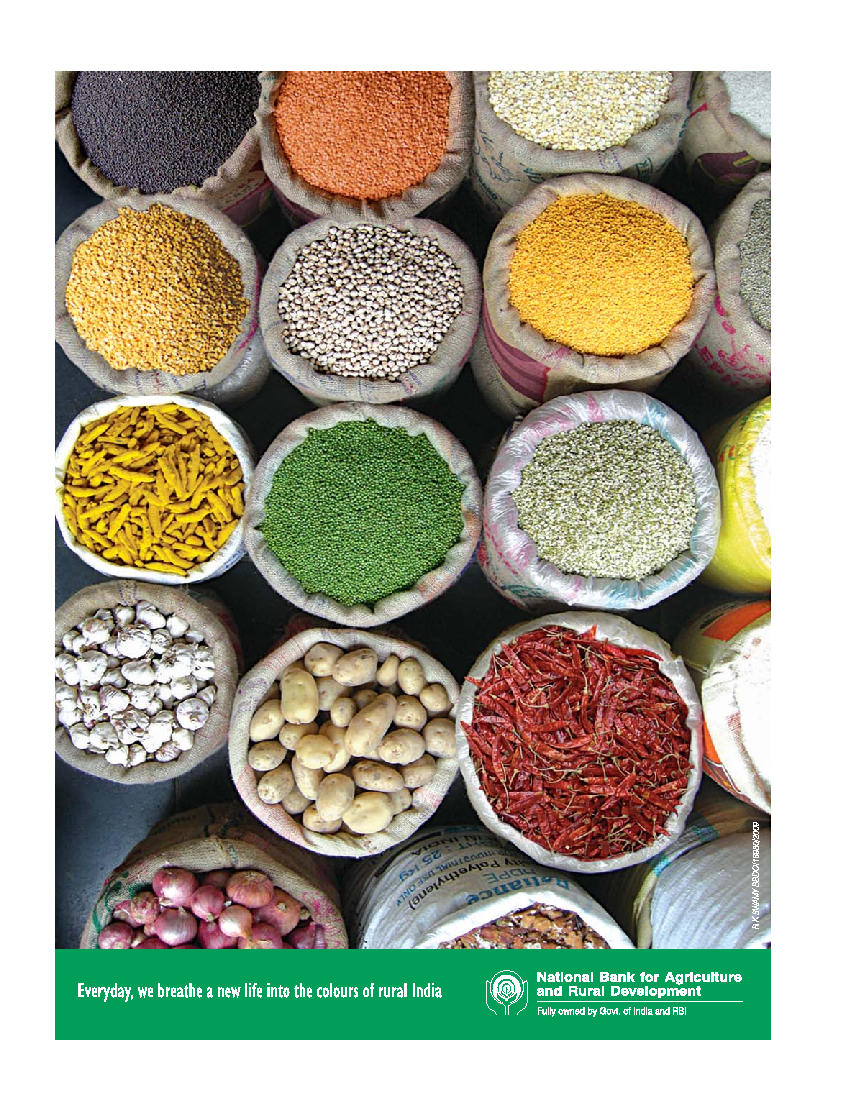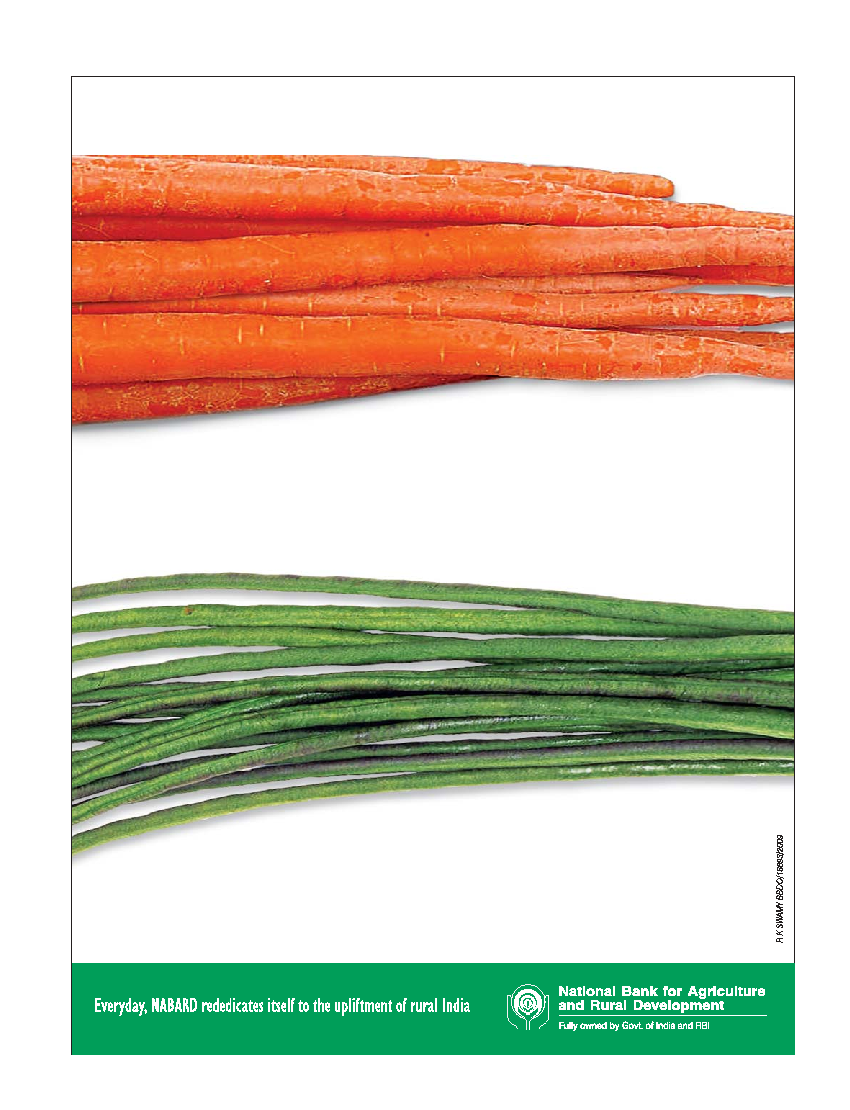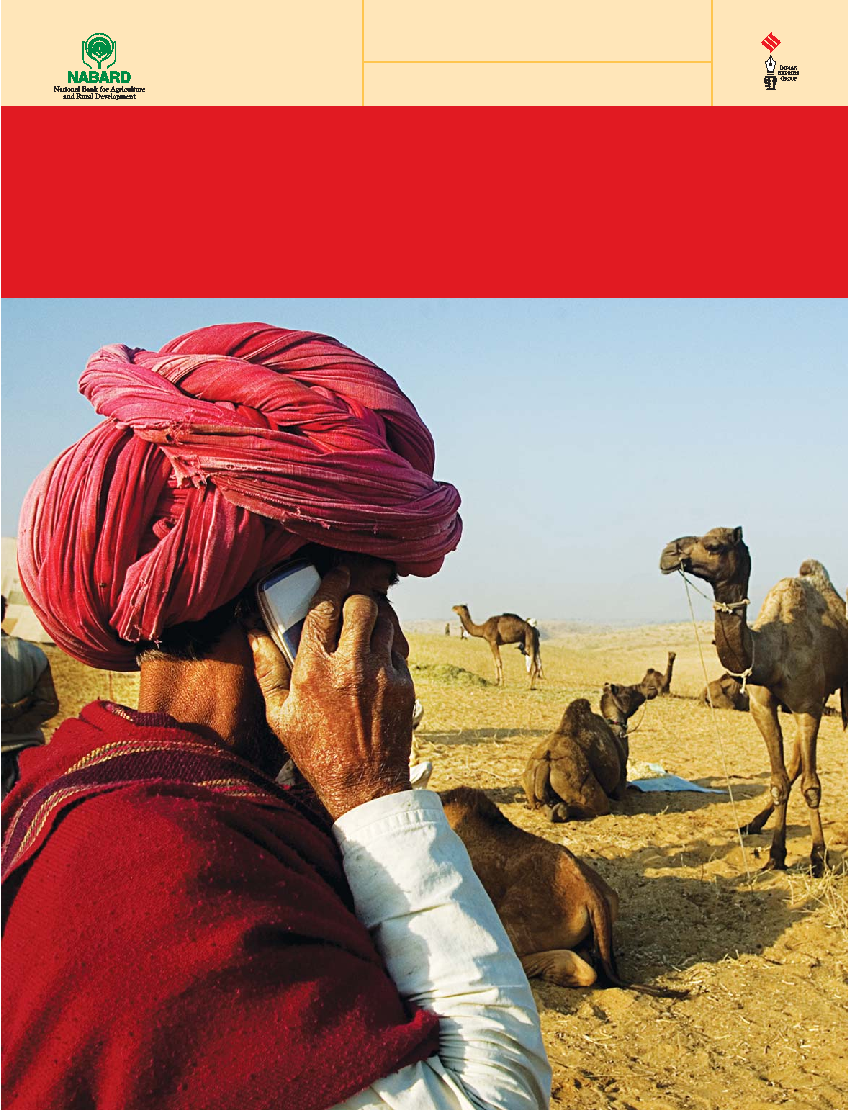
APRIL JUNE 2009
COMPLIMENTARY WITH THE FINANCIAL EXPRESS
MICROFINANCE
AN INSIGHT INTO THE WORLD OF MICROFINANCE
W O R L D
The Success of
Microfinance in India
The Success of
Microfinance in India
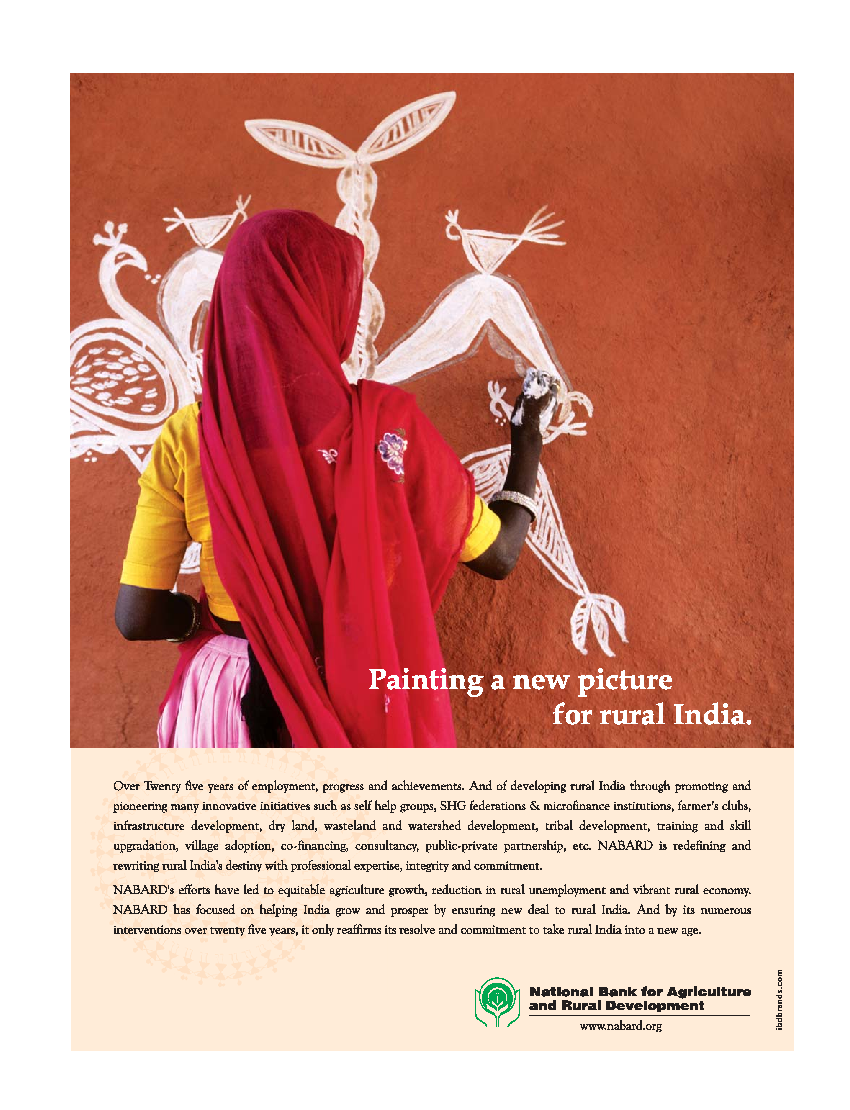
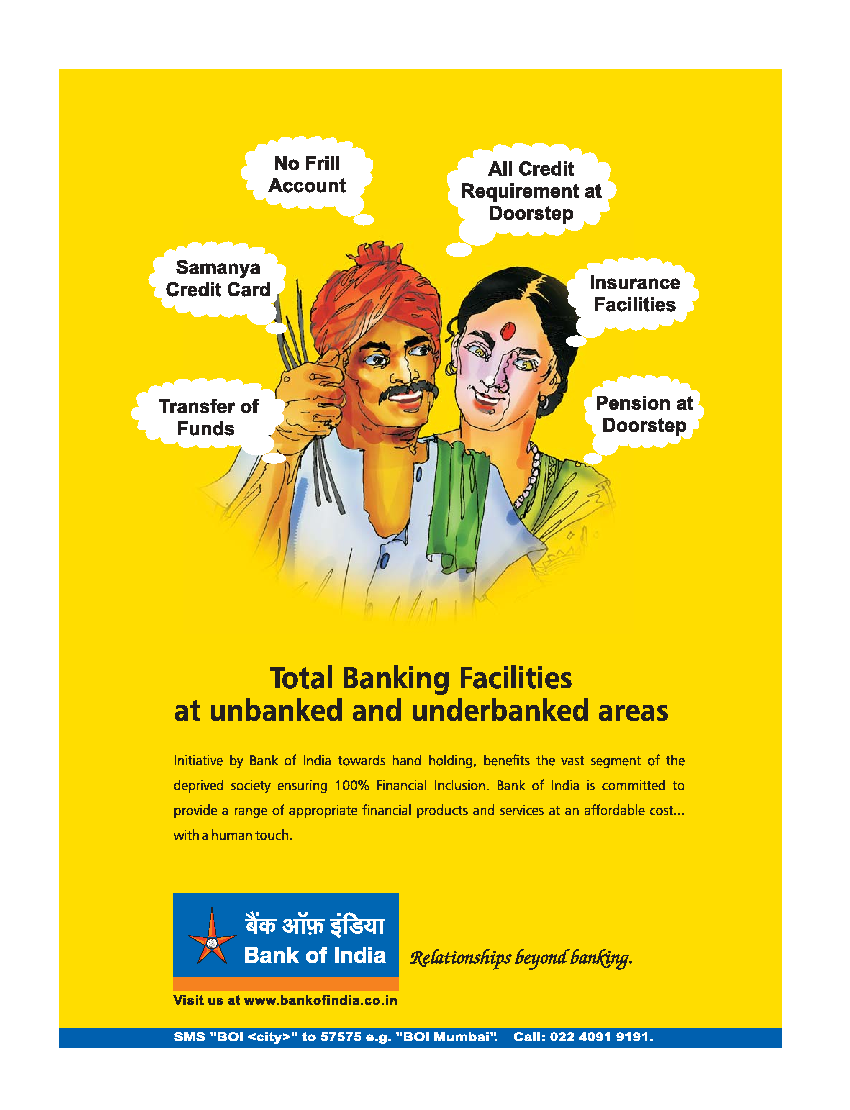
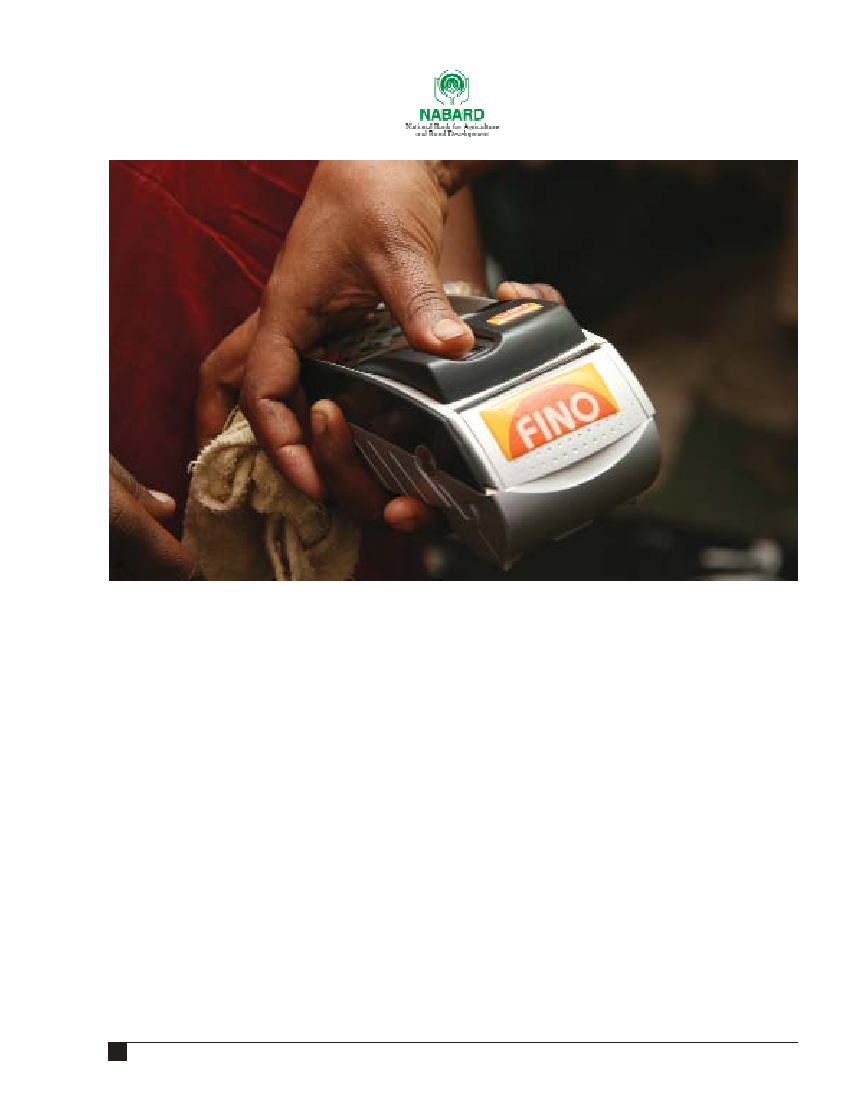
Page
4
The success of microfinance in India
Page
9
Microinsurance market in India
Page
10
`Let's now ask banks who is credit-worthy: the rich who
don't pay back or the poor who do'
Interview with Muhammad Yunus, Grameen Bank
Page
13
Outreach should broaden
Page
14
Small is profitable
Page
15
Microinsurance: A snapshot
Page
16
Grain banks and self help groups
Page
19
Leading the way
Page
20
`We have been growing at 200%. By 2009 end we should
have over 60-65 lakh customers'
Interview with Suresh Gurumani, CEO, SKS Microfinance
Page
23
The Impact of financial crisis on microfinance
Page
25
We are concentrating in direct SHG Bank Linkage
Programme to reach out to more SHGs directly
Interview with MS Sundara Rajan, CMD, Indian Bank
Page
26
`MFIs, if linked with livelihood, have a very crucial role
to play in the growth of the economy'
Interview with Ela R Bhatt, founder of SEWA
and Sa-Dhan
Page
28
`Our efforts in the new fiscal year will be focused around
customers and competencies'
Interview with AP Ghugal, GM, Priority Sector Credit
Department, Bank of India
Page
30
Models for achieving financial inclusion in India
Page
32
Towards inclusive growth
MICROFINANCE WORLD | April 2009
2
[
CONTENTS
]
Cover photograph: Sandipan Majumdar, Kolkata/CGAP
Microfinance Photography Contest
CONTENTS
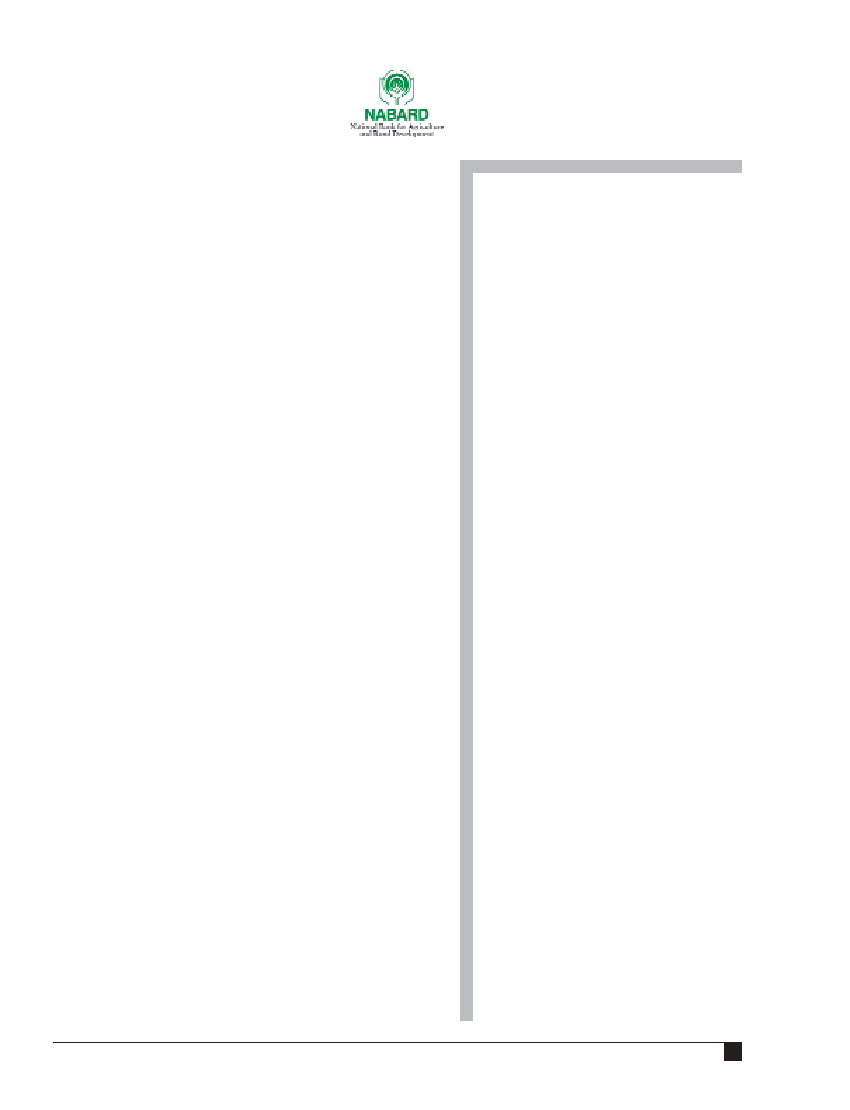
April 2009 | MICROFINANCE WORLD
3
[
FOREWORD
]
CONSULTING EDITOR
M
ONALISA
S
EN
monalisa.sen@expressindia.com
DESIGN
A
NOOP
K
AMATH
SPECIAL PROJECTS TEAM
G. S
UBRAMANIAN
g.subramanian@expressindia.com
2nd floor, Express Towers,
Nariman Point, Mumbai 400 021
Tel: 022- 22022627 Ext: 389
Fax: 022- 22022639
PRODUCTION
B.R. T
IPNIS
General Manager
Copyright: The Indian Express Limited. All
rights reserved. Reproduction in any manner,
electronic or otherwise, in whole or in part,
without prior written
permission is prohibited
A SPECIAL PROJECTS INITIATIVE
HOW TO REACH US
We prefer to receive letters via email,
without attachments. Writers should disclose any
connection or relationship with the subject of
their comments. All letters must include an
address and daytime and evening phone
numbers. We reserve the right to edit letters
for clarity and space.
Mail: Monalisa Sen
Email: microfinance@expressindia.com
MICROFINANCE
WORLD
The Indian Express Limited
2nd floor, Express Towers,
Nariman Point, Mumbai - 400 021
M
icrofinance is evolving and the coming years will
see it making a definite impact across rural and
urban India giving hopes and opportunity to mil-
lions to raise their standard of living. There are success stories
to suggest that its intervention is not a poverty alleviation
measure. But coupled with appropriate framework micro-
finance could lead to sustainable and profitable economic
activity as well.
As per the Global Environmental Monitor, small and
medium enterprises powered by microfinance contribute
significantly to the economic growth of the society. For
microfinance to be an effective tool to spur economic growth,
it is believed that micro-loans need to be used more for enter-
prise building at the bottom segment of the pyramid. In
Bangladesh, about 15 million families now benefit from small
loans and other financial products such as micro savings and
microinsurance. It has resulted in 40% of the overall reduc-
tion of rural poverty.
However, not all microfinance intervention leads to
economic activity although millions of people around the
world have been taking benefit out of it. Reports have shown
that a substantial portion of the microfinancial services are
used for consumption or for a mix of consumption cum
enterprise building activities.
Over the years the dynamics of financial inflow to the
microfinance sector has undergone radical changes. Started
with grants and soft loan fund to take up small microfinance
intervention, now large institutions are tapping huge capital
funds from global equity investors. The whole range of invest-
ment instruments like equity, debt, soft loan, revolving fund,
grant money and other institutional support funds are now
available to the microfinance institutions.
The diverse models and approaches have helped in reach-
ing out to new regions and to populations which have
remained excluded from financial services. The government
should ensure transparency and full disclosure of rates
including fees.
M
ONALISA
S
EN
Consulting Editor
DEAR READER,
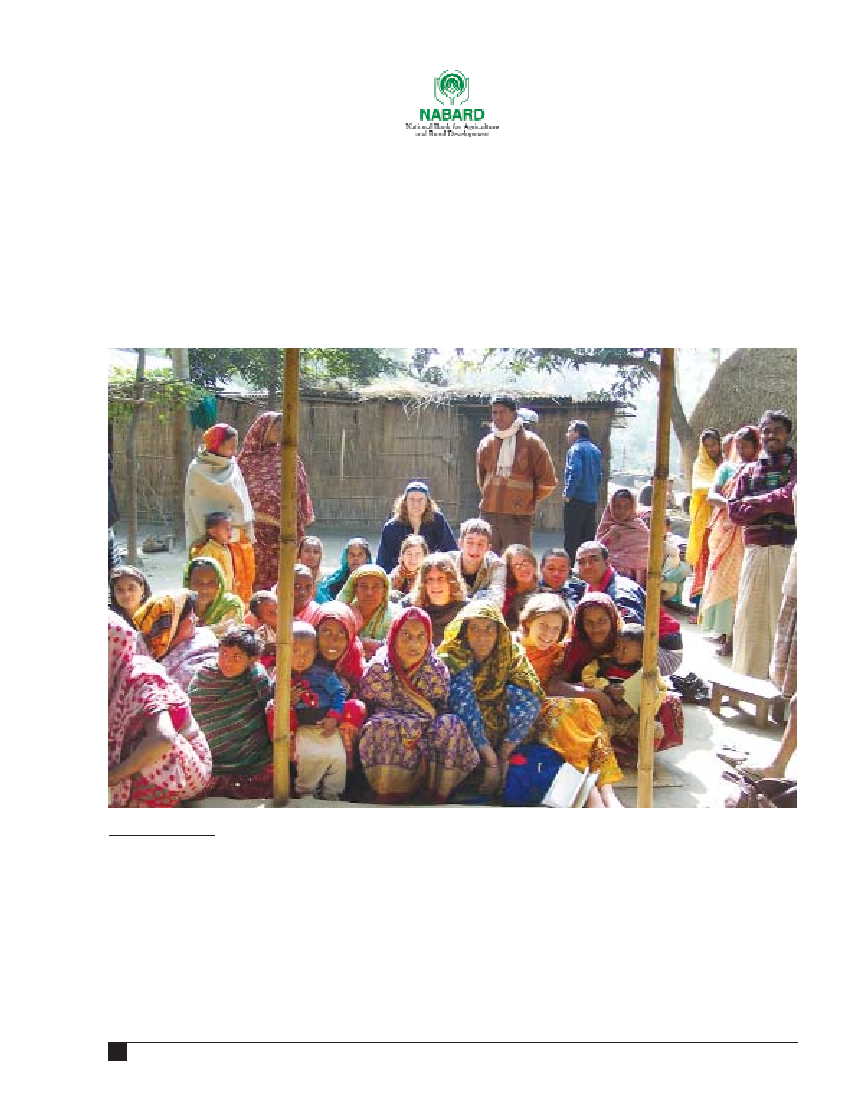
ASHOK B SHARMA
D
elivery of credit at the doorstep of those who are
not covered by the formal banking business, cou-
pled with capacity building, is one of the ways for
achieving financial inclusion. Such a financial inclusion of
the poor can be more fruitful if the credit disbursed can
help them become entrepreneurs than meeting only their
consumption needs. The process can also be accentuated
if the disbursing microfinance institutions (MFIs) incul-
cate a habit of savings by attracting deposits and come out
with insurance products covering various risks.
The Nobel Laureate from Bangladesh and the founder of
the Grameen Bank movement, Muhammad Yunus, has
termed the microfinance disbursement as "a social busi-
ness" in contrast to the commercial business of banks and
financial institutions. There should be a separate regulatory
authority for MFIs as distinguished in character from that
for the commercial banks. The regulatory authority for MFIs
should evolve guidelines keeping in view the objectives of
socio-economic development of the poor, he suggests.
According to Yunus, MFIs should be self-sustaining, be
allowed to attract deposits, provide insurance and pension
fund, and should be capacity building.
THE SUCCESS OF
MICROFINANCE IN INDIA
Financial inclusion of the poor can only be possible if the MFIs inculcate a habit of
savings and come out with insurance products covering various risks
MICROFINANCE WORLD | April 2009
4
[
COVER ST
ORY
]
Grameen Bank meeting
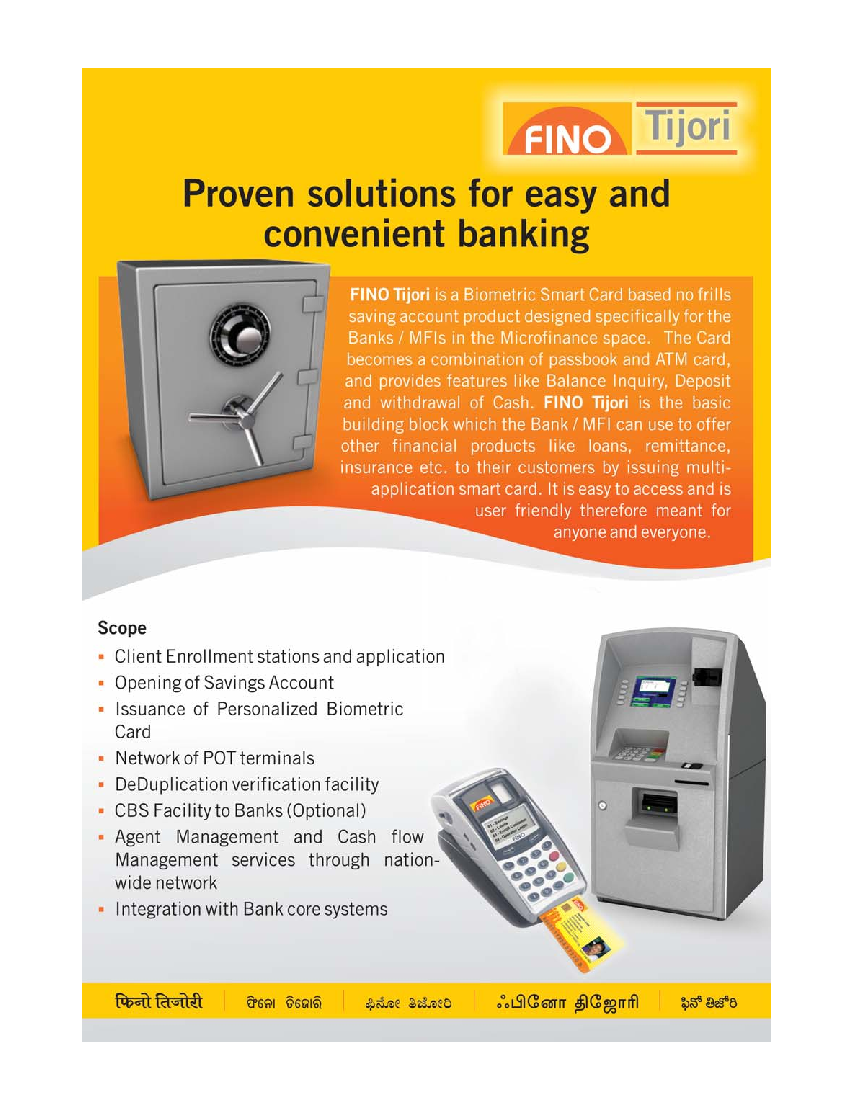
HTTPWWWFINOCOIN
4EL
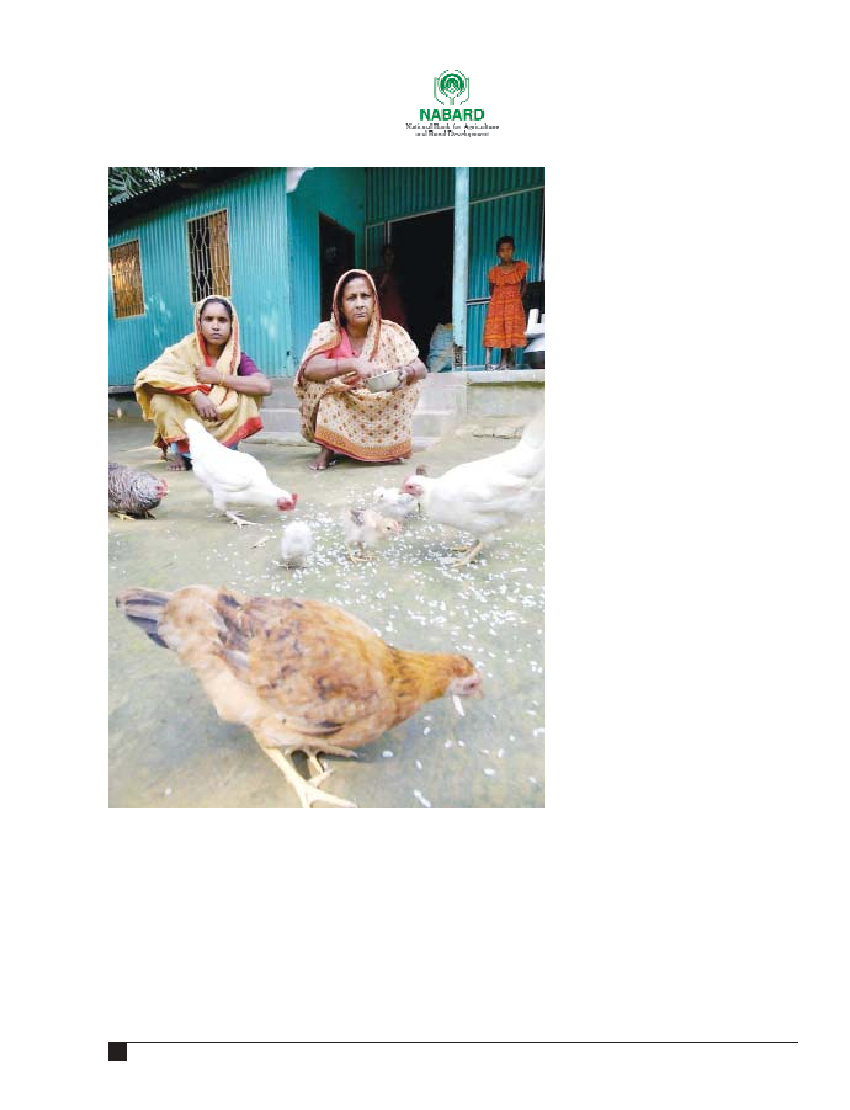
If MFIs are owned by borrowers, there should be no pay-
ment of licence fees. MFIs can source funds from banks.
He is, however, not in favour of MFIs sourcing funds from
outside the country. Funds should preferably be mobilised
and distributed locally, he opines.
The interest rates should preferably be lower. MFIs
should ultimately be owned and operated by borrowers, as
is in Bangladesh. There should not be any scope for individ-
ual profit in MFIs. All profits should be ploughed back in the
MFIs for meeting the costs of transactions, he suggests.
According to Yunus, this is the right time for the micro-
finance movement to grow and spread in India. It can
counter the adverse impact of the cur-
rent global financial crisis and provide
jobs and self-employment to many.
He holds the global banking and finan-
cial institutions responsible for the cur-
rent global economic crisis as they have
befooled the investors via mere paper
transactions. "Banking regulations
should clearly distinguish between gam-
bling and business. There should be
proper in-built mechanism to prevent the
business from running into trouble and
insurance schemes should be in place for
protecting deposits. The government
should not bailout these institutions by
doling out public money," he says.
The microfinance institutions should
cater to the `real economy' and livelihood
of millions of poor. The developing coun-
tries like India and Bangladesh have been
largely insulated from the adverse impact
of the current global financial crisis due
to the presence of the `real economy', he
says. In Bangladesh 80% of the poor are
covered under microfinance. The remain-
ing 20% are expected to be covered with-
in the next two years.
India has been able to cover only 20%
people under it and needs to speed up,
he suggests.
In India, a Bill for regulation of MFIs is
pending in Parliament since 2007. The
proposed legislation has been delayed
on the issue of lowering of interest rates.
A joint secretary in the banking division
of the finance ministry, Amitabh Verma,
says the government is very keen on
MFIs lowering their interest rates. The
MFIs should carry out their operations without any sub-
vention of interest rates by the government. Bangladesh
has set up a regulatory authority for the Grameen Banks
and another legislation for approval of MFIs as social
banking institutions is pending for approval.
Citing a few instances of social business, Yumus said,
students in Bangladesh were given loans, most of who
have opted to become entrepreneurs after they completed
their studies. Interest-free loans of 1,000 taka were given to
1,00,000 beggars, 15,000 of which have stopped begging
and set up small business. Loans without any interest was
an exception in case of beggars. As a general principle,
MICROFINANCE WORLD | April 2009
6
[
COVER ST
ORY
]

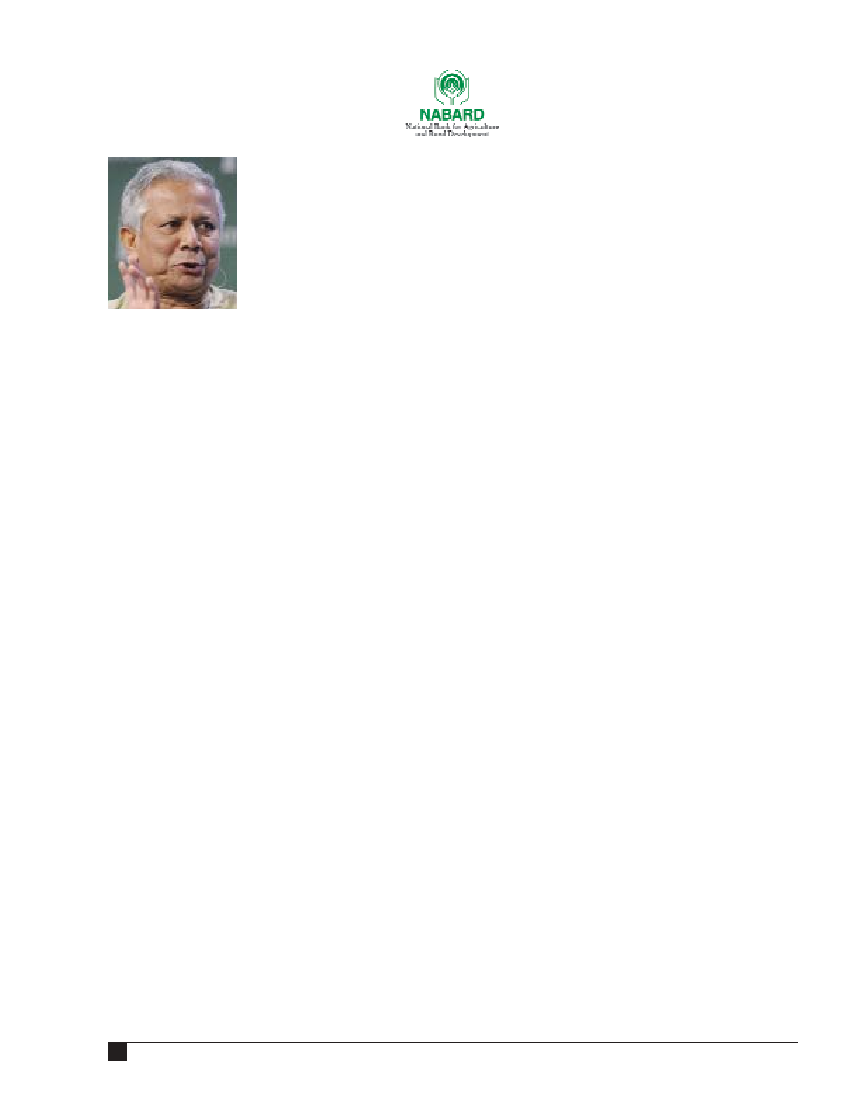
MFIs should charge interests on loans to cover their trans-
action costs. Prudence suggests that cost of transaction
should be minimised and interest rates should be kept low.
MFIs in India, however, allege that their interest rates
are higher (mostly in double digits) as they have to cover
the costs of transactions and capacity building.
According to Amitabh Verma, bank's refinance rates to
MFIs are not likely to be less than 7%. Also, the govern-
ment may not be in a position to render subvention on
loans. Therefore, the MFIs should find novel ways for
covering or hedging their costs.
MFIs apex body Sa-Dhan's executive director Mathew
Titus said; "The microfinance sector in India is going
through a difficult and a challenging phase. Extraordinary
growth, global credit crunch and increased awareness of
social impact pose a challenge. It is an opportune moment
for house keeping and clearing up concerns that have
been around for a while. Growth and competition need to
be addressed in the common spirit to serve the poor.
Transparency is the key property that microfinance must
subscribe to."
Microfinance in India touched the 33.6 million clients-
mark in 2007-08, of which 14.1 million were served by
MFIs, according to Sa-Dhan estimate. Other estimates put
the client outreach at over 100 million. These estimates
may differ but there is an unanimous acknowledgement of
the fact that over 90 million low-income households still
remain unserved. Therefore, microfinance must grow
steadily and steeply. All indicators point to a flattening
growth curve. However, these were computed before the
global financial crisis and the growth path may even suffer
a dent, according to some experts. This means not only
unserved clients will have to wait longer but also the exist-
ing clients are likely to see their credit flow slowing down
and shrinking.
There is no possibility of a steep growth from grant
financing at this stage. In a given period, grants are just
not large enough. The same holds true for profits that, in
theory, can be generated from a granted corpus. If profits
are huge enough, the organisation would either cease to
be a community development finance by charging in
excess of traditional moneylenders or serve non-poor
clients. Savings could be a very feasible option, particular-
ly in the long run. Only cooperatives are legally entitled to
mobilise savings. Some of the experiences suggest failures
of cooperatives. However, cooperative legislations in sev-
eral states like Andhra Pradesh led to reforms in the coop-
erative model. The outcome is the legal form of MACS,
which is the registration for many SHG federations.
There are about 75,000 SHG federations functioning in
India and are an important avenue for managing an ever-
expanding number of SHGs. The SHGs federate into a two
or three-tier structures and take up a range of services,
both financial and non-financial. They have so far not
been included formally into the SBLP and have strong
points in their favour like cost efficiency and democratic
governance. Besides lacking exposure to these relatively
new organisations, bankers often raise concerns about
level of professionalism of federation management, viabil-
ity of the business model including dependency on the
self-help promoting institution (SHPI) and political inter-
ference. The idea of a national-level SHG federation is
being debated to address the issue.
Bankers are generally comfortable in extending re-
finance to the non-banking financial companies (NBFCs)
because equity serves as a lever for credit. Banks are usu-
ally concerned over the creditworthiness of MFIs and SHG
federations' portfolio quality, profitability, governance and
viability of the business plan. Incidentally, the involve-
ment of investment funds regularly brings about improve-
ments in all these areas. Bankers rely more on existing sys-
tems and structures, though some emphasise on the mer-
its of a long-term relationship, their loan terms are mostly
24 to 36 months. Therefore, it is essential that MFIs and
SHG federations go for credit ratings. Meanwhile, Nabard
has a scheme for subsidised credit rating for MFIs and
SHG federations.
However, microfinance can grow from the perspective
of demand only if adequate resources flow to MFIs and
self-help groups (SHGs). There are four main options for
capital mobilisation -- grants, profits, savings and invest-
ment. Grants and profits, however, are unfeasible.
MICROFINANCE WORLD | April 2009
8
[
COVER ST
ORY
]
"Banking regulations should clearly distinguish between gambling
and business. There should be proper in-built mechanism to
prevent business running into trouble. There should be insurance
schemes for protecting deposits. Government should not bail out
these institutions by doling out public money."
Muhammad Yunus, founder of the Grameen Bank movement
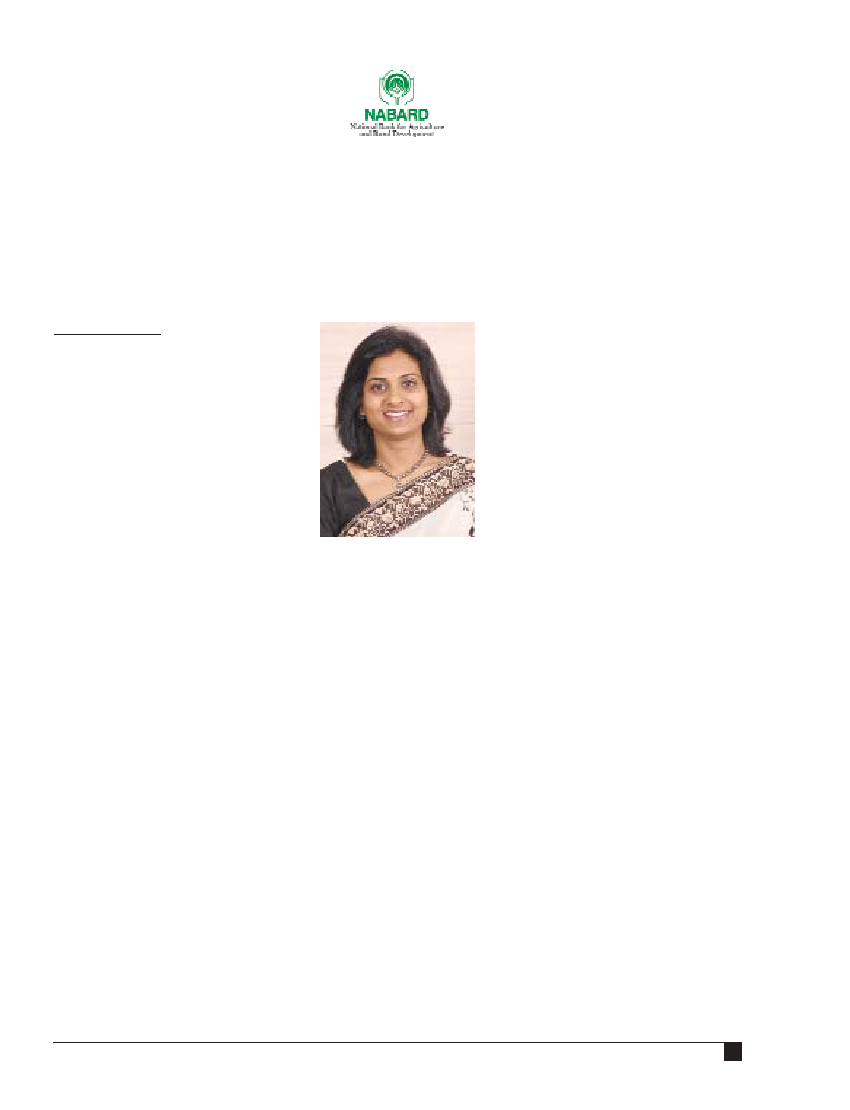
April 2009 | MICROFINANCE WORLD
9
[
COL
UMN
]
MONICA AGRAWAL
M
icroinsurance aims to provide
protection and inculcate the sav-
ings habit for the customers at
the bottom of the pyramid. Some time in
their lives, most people experience finan-
cial difficulties with potentially long lasting
results. This is especially true for the poor
in developing countries. Any natural
calamities and disasters to the poor are
considered to be the severely shocking haz-
ards, which is hard for them to recover
from. There is therefore a growing realisation of the need
for microinsurance products in our country.
It represents an untapped market of nearly $2 billion in
India alone, according to a study released by the United
Nations Development Programme (UNDP). Demand for
microinsurance in India has remained low in a large part
because of a severe mismatch between services offered by
insurers and the needs of the insured. The present out-
reach of microinsurance is around 5 million people, cover-
ing only 2% of the poor in the country.
Challenges
Microinsurance delivery in India is fraught with chal-
lenges. A major hurdle is the acceptance of microinsur-
ance among the rural poor who not only have low levels of
awareness about possible risks to their lives but also lack
trust in most financial schemes structured for the long
term with no immediate benefits. Non-availability of
authentic admissible documentation during enrollment
and claims processing and a lack of facilities for premium
remittance further adds to the complexity in insurance
administration in the remote and far-flung pockets of
India. Despite the numerous challenges, insurance com-
panies have in the recent past made significant inroads to
take insurance to the masses at the bottom of the pyramid.
Microinsurance at Aviva
Our Vision statement for the Microinsurance Business
Vertical is "To cover risks to the lives and
livelihoods of the poor and underprivileged
at an affordable cost." Aviva has been pro-
viding insurance to protect the lives and
livelihoods of the economically weaker sec-
tions of society in partnership with organisa-
tions such as Basix, Aarohan and Paras Cap
Fin. Today, we cover more than 1.5 million
lives and have settled close to 6,000 claims.
We have a well established microinsurance
practice focussing areas such as customer
friendly products customised to the LIG seg-
ment needs; affordable and lean processes
to cater to the unique dynamics of this segment; world class
customer service experience and demonstrated capability
in claims settlement.
We have been developing microinsurance products in
consultation with our distribution partners. Our popular
microinsurance products include Credit Plus, Credit
Suraksha in the group category and Grameen Suraksha for
individual lives. Credit Suraksha and Credit Plus are cred-
it-linked products largely for MFIs and SHGs. Grameen
Suraksha, on the other hand, is a traditional term plan
under which the policyholder pays a premium for a period
of two years and avails an insurance cover benefit for
either 5 or 10 years. The minimum cover available is
Rs 5,000 and the maximum is Rs 50,000. Additional flexi-
bility is also offered such that the customer continues to
be covered for an extended period of 18 months (for the
five-year plan) or 48 months (for the ten-year plan) even if
she or he is unable to pay the second annual premium.
Summary
The microinsurance market has seen a lot of activity in the
recent past and new customer service standards are being
set in a market that has long been sidelined for its non-
profitability and complexity. However, a lot of ground
needs to be covered before we see tangible results in terms
of increased insurance penetration and adequate risk cov-
erage for the rural poor.
The writer is Director Corporate Initiatives, Aviva India
MICROINSURANCE
MARKET IN INDIA
The risk coverage to the poor will help them to recover from natural calamities
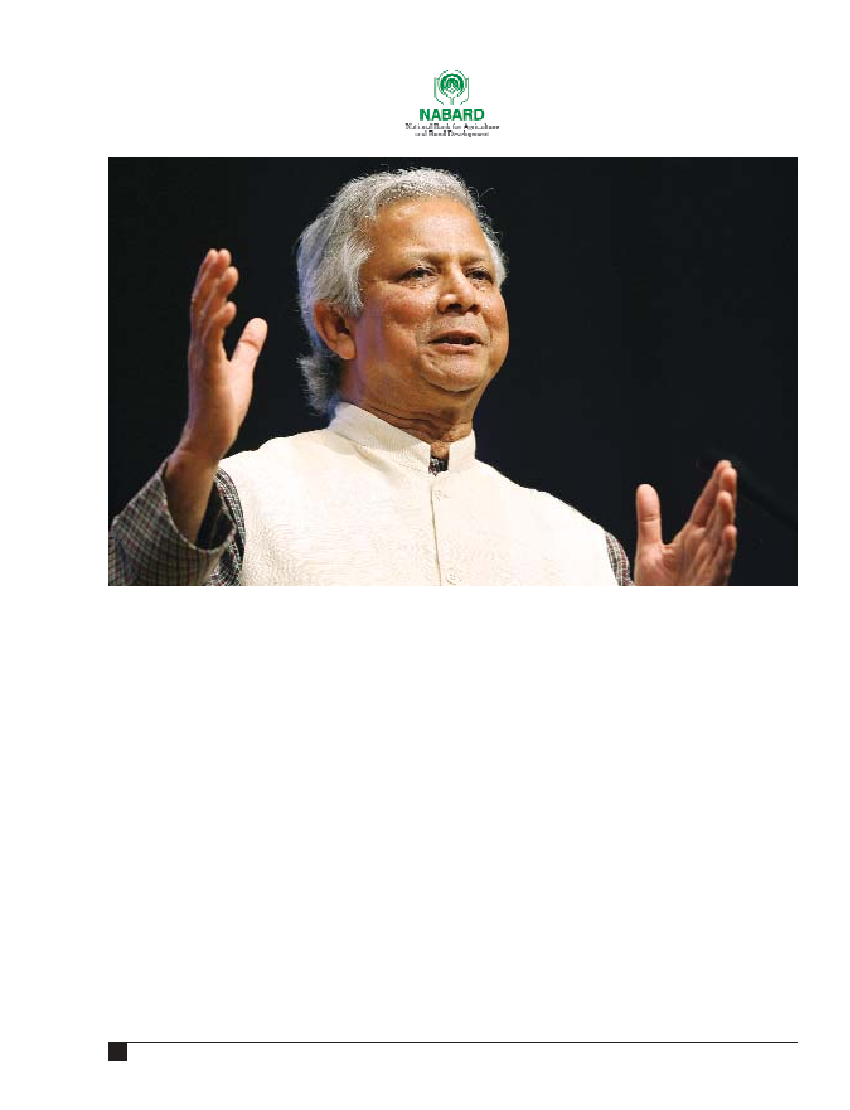
In the new financial crisis, how different will the role of
micro-credit banks be?
Micro-credit is not impacted by the financial crisis for the
simple reason that it is not exposed to the international
financing system. Micro-credit is close to the real people.
That is one of its strengths. Another strength is that we
don't borrow from the international market--it is local
money going to local people. Third, while the convention-
al banking system is collapsing, micro-credit has a high
repayment rate that is based on no collateral and no legal
papers--it functions beautifully. So, today, we can raise the
same old question we raised 32 years ago when banks told
us that the poor are not credit-worthy: who is credit wor-
thy? The poor are the ones who are paying back and it is
the rich who are not paying back. The crisis has allowed
the world to challenge the financial system. I am in favour
`LET'S NOW ASK BANKS WHO IS
CREDIT-WORTHY: THE RICH WHO DON'T
PAY BACK OR THE POOR WHO DO'
With his Grameen Bank, Muhammad Yunus, winner of the Nobel Peace Prize,
redefined the concept of lending. In an interview with FE, Yunus speaks about the
current economic crisis and explains the role of micro-credit banks in dealing with
poverty. Excerpts:
MICROFINANCE WORLD | April 2009
10
[
INTERVIEW
]
Bloomberg

of redesigning it and redoing it. Going back to the same
system would be the worst kind of mistake we can make.
Of course, terrible things are happening but we should
look at this as a great opportunity.
Farmers complain that there are too many checks and
balances when they approach banks and financial
lenders for loans but the same checks evaporate when
banks lend to big business houses.
Interest rates in micro-finance should be as low as possi-
ble because we are not in the business for money. The idea
is to help people out of poverty as fast as we can. In micro-
financing, we give loans to the poor--without collateral
and without any legal instruments--for income-generat-
ing activity with the lowest possible interest rate. That is
micro financing.
Does the potential of micro-financing end once people
are above poverty line or does it have the potential to
take them even higher?
We make entry into micro-credit very difficult, unless you
are extremely poor. We have a tough screening process--we
want to make sure we are getting to the person at the bot-
tom. So if you are a poor person who lives in two-room
house, please wait, we are looking for people who live in a
single room. Once you qualify, you will never be denied. You
can become the richest person in the world but we can still
fund you because you had qualified and now you are an
example for us. You will inspire others; you are the owner of
the bank--Grameen Bank is owned by the borrowers. No
one has to leave, everyone can stay as long as they wish.
How well does the system work?
It is very strong. If you are successful and I am not as suc-
cessful, I copy you and see if I can benefit from that. It hap-
pens a lot. For example, we encourage everyone to send
their children to school--100 per cent of the children of
Grameen families are in school. They want to make sure
that their children go as high as possible and Grameen
Bank gives them a student loan. Right now, there are more
35,000 people with student loans from the Grameen Bank
in business schools, medical schools, engineering schools.
So you inspire each other. That is the advantage of having
groups, having weekly meetings and so on.
What is the legal position on NGOs' lending capacity?
If an NGO wants to lend money to poor women, the law
can come and say you are under arrest, you are violating
the law because in order to lend money, you have to be a
moneylender, registered under the Moneylenders Act or
you have to be a bank. For example, if you take people's
savings and then disappear, who will stop you when you
are not registered? NGOs who are doing good work as
micro-credit organisations should be given the status of a
micro-credit bank. You can give them standardised inter-
est rates so that it is transparent.
People ask me, why don't you convert yourself into a
bank? I say this is a ridiculous proposition. Banking law is
created to create big banks. These big banks are like cargo
ships. A micro-credit bank is like a dinghy boat that goes
into shallow water, ferries a little merchandise. You cannot
construct a dinghy boat from the architecture of an ocean-
going vessel. This is the difference. Why don't we make the
architecture of a dinghy boat--what is so difficult about it?
Grameen Bank has a law that applies to it, it is a specialised
bank. We say, why don't you generalize this law so that any-
body can begin a Grameen Bank in Bangladesh? Millions
and millions of people need financial service. This is a busi-
ness but a business with a completely different purpose--
to help people create their own employment. In the context
of this financial crisis, this becomes more important
because people will be losing their jobs, will be losing liveli-
hoods. So if you can create financial systems of micro-cred-
it, they can create self-employment opportunities.
The India government has used the loan waiver as a
means to address issues of poverty. Your experience has
been that micro-credit borrowers are extremely good
repayers. Is there a clash between the two models?
Politicians are not bankers. They want political solutions.
Waiver is a political solution--it is a good way to ask for
votes but that is not a financial system which is tenable.
Once you waive a loan, you are not only doing harm to the
present cycle but you are giving incentives to people in
future not to repay and pressure the government to waive
loans. If I have to waive a loan, I would do it by giving them
cash--because if you borrow, you have to pay back. That is
the culture we have to build, otherwise the banking system
will not work. Bangladesh is a country where disasters are
April 2009 | MICROFINANCE WORLD
11
[
INTERVIEW
]
The crisis has allowed the world to challenge the financial system. I am in favour of
redesigning it and redoing it. Going back to the same system would be the worst kind
of mistake we can make. Of course, terrible things are happening but we should look
at this as a great opportunity

frequent. Many families start from zero after floods but we
never waive their loans. The standard practice at Grameen
Bank is that as soon as the disaster hits, the branch is con-
verted into a humanitarian organisation. All banking
activities cease to exist. Once the crisis is over, we take care
of these families, help them start some kind of activity to
keep them working. We issue new loans, new houses.
Slowly, you pay back. We take your loan and convert it into
a long-term one. Our system is that no matter how long it
takes to pay back the loan, the interest can never exceed
the total principal. Our policy is to make sure people get
back on their feet. If people are not on their feet, the bank
will not be on its feet.
Does your bank have something for the urban poor?
When I was drafting the law for Grameen Bank, I put in a
provision that this bank will never work in any urban
centre. Now, we are asking the government to amend it
because we have already covered the villages of
Bangladesh. Only the cities are left. In rural areas, we now
have 7.7 million borrowers--97% women. Basically, this
is a bank for poor, illiterate women--they own the bank.
Our board is made up of their representatives, chosen
by them.
How do you see Grameen activities in India?
There is no Grameen Bank in India, just a Grameen-type
programme because there is no law to allow this type of a
bank to be created here. Those that exist are restricted
since they cannot take deposits. Most of the time they run
around for funds rather than concentrate on the work.
Grameen Bank can grow as each branch is dependent on
the deposits it can mobilise from the area and lend the
money to the local people. A Grameen Bank branch is like
an independent bank by itself. We want to build our own
capacities but because the law doesn't support this in
India there are limited capacities.
How did Grameen America, your New York venture,
come about and how does the model work?
It is said micro-credit cannot work in the United States
because it is a different country, a rich country, etc.
Grameen Bank started in USA in 1987 when as Governor
of Arkansas, Bill Clinton invited me. I had a meeting with
him and his wife Hillary Clinton. They were eager to
understand our work. He said we need this in Arkansas
because this is the poorest state in the US. That was the
beginning and Hillary Clinton was the chairman of the
committee running this bank. After he became President,
that programme was folded up. Then somebody from
New York wanted it there. So, last January, we launched it
in Jackson Heights. We deliberately chose Jackson
Heights because in Arkansas we had a lot of trouble giv-
ing loans to people. Their welfare law is funny: if you
somehow earn one dollar, you have to report it to the
welfare authority and welfare authority will diligently
deduct this dollar from your cheque. That is shocking. If
I were in charge of drafting this law, I would have done
just the opposite. So we wanted to choose an area where
welfare has not penetrated yet. We followed every single
principle of the Grameen Bank. Whatever you see in a
Bangladeshi village, you see in Jackson Heights. We sent
somebody from Bangladesh to start the programme and
we chose somebody who has never been to the United
States so that he does what he does in a Bangladeshi vil-
lage. He will not feel embarrassed about it. Today, we
have more than 5,000 borrowers, all women, some
Caribbean, some Latinos, some Indians. Repayment is
99.6% and while big banks are collapsing in the same
environment, this bank is flourishing. Now everybody
wants a Grameen programme. In Grameen Bank, the rule
requires that every borrower must open a bank account.
Whatever little money you earn every week, you deposit
that in the account. So to open an account for a woman
who saves two dollars a week was the greatest hurdle in
the entire project. We are getting a lot of invitations, even
one from Warren Buffet. His daughter Susan invited us to
Omaha, Nebraska, because Omaha is very poor.
Everybody is in the pipeline.
We often speak about `social business'. Can you explain
the concept?
The basic thing that went wrong in the current financial
crisis is that the capitalist system made the human being
appear as a uni-dimensional being and created a theory:
that all they do in their economic life is to make money. I
say, yes, making money is an exciting goal but human
beings are multi-dimensional beings. There are many
other things we take pleasure in doing--selflessness is
one. That is where we went wrong. Why don't we create
separate businesses on the basis of selflessness? If people
can give away, why not use the money to design a business
which helps people--say, something to tackle malnutri-
tion. So at the end of the year, instead of asking the com-
pany how much money it made, you would be asking how
many children it got out of malnutrition.
This financial crisis is an opportunity for us to incorpo-
rate the idea of social business. Money-making business
has failed the world. If we bring the social business into
the picture, some balance can be restored.
MICROFINANCE WORLD | April 2009
12
[
INTERVIEW
]
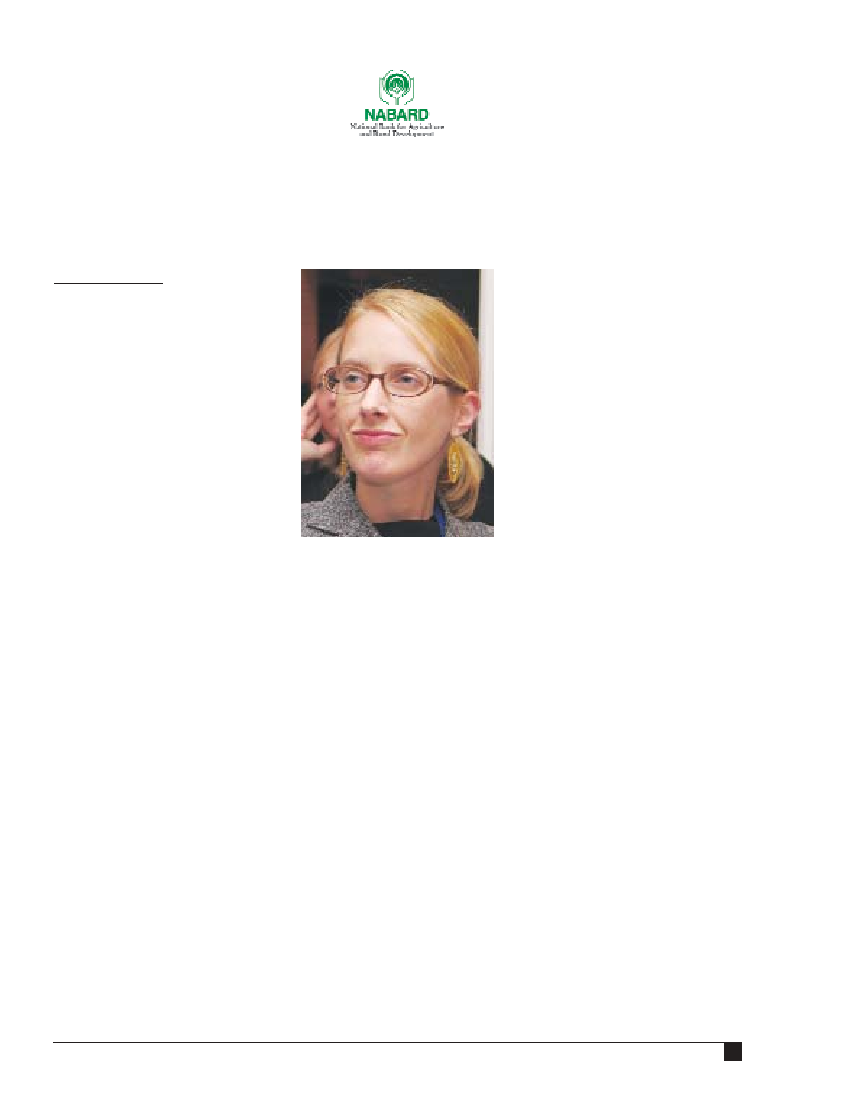
JENNIFER MEEHAN
T
welve months ago, in a candid
conversation with a mentor and
friend on the state of microfi-
nance for the poor in India, I heard a
comment that stopped me in my
tracks: India was in danger of declaring
microfinance a huge success while tens
of millions of poor families continued
to lack access to the most basic of
financial services.
No doubts, India is one of the most
dynamic microfinance markets in the
world. A combination of visionary social
entrepreneurs, huge demand for micro-
finance services and the availability of local commercial
debt capital (and in some cases equity capital) has fuelled
rapid and enviable growth in the sector. It is estimated that
almost 55 million households are currently being reached
by specialised microfinance institutions and through the
NABARD-supported self-help group approach.
Yet, for Grameen Foundation, growth in and of itself is not
a sufficient measure of the microfinance success. It is the
quality of growth, as well as the quality of the services being
provided that matters. Are the poor and poorest actually
being reached with financial services in a timely and honest
manner? Are those services designed to enable them trans-
form their lives?
These questions dominated the recent Sa-Dhan microfi-
nance conference in New Delhi, headlined by two global
leaders in microfinance, Muhammad Yunus of the Grameen
Bank in Bangladesh and Ela Bhatt of Sewa in India. These
two visionaries, along with social entrepreneurs across the
world, became barefoot bankers by accident--because of
its transformational impact on the lives of the world's poor-
est people.
We believe that financial and social success in microfi-
nance are not mutually exclusive, but rather mutually
dependent. Financial sustainability is required to grow
microfinance to the scale of the problem--global poverty--
and a measurable impact on lives is required to fulfill our
underlying purpose and mission.
Grameen Foundation first began working in India
almost a decade ago when many of
today's leading and fastest-growing
microfinance institutions were still
experimenting with different solutions.
There are three trends in India that give
us pause for thought: 1) there is
increasing anecdotal evidence that the
poor are not being served in large
numbers, especially in the North and
East 2) The micro finance institutions
that have accessed commercially ori-
ented equity financing are moving,
either consciously or not, away from
serving the poor who are more expen-
sive to reach, thereby reducing prof-
itability 3) There are a few MFI `biggies'
that dominate the microfinance market, leaving innova-
tive smaller and younger institutions to struggle to grow
in order to maximise their impact.
Over the next year, we will advance our double bottom
line agenda in India in three ways. First, by promoting
the missing piece of the double bottom line puzzle--
social performance in general and our Progress out of
Poverty Index (PPI) tool specifically. With this tool, we
can finally move beyond anecdotes and get verifiable
data whether the poor are being reached and how their
poverty levels are changing with access to microfinance
services. Second, we will--in collaboration with
Grameen Capital India--provide catalytic capital to Tier-
II institutions working with the poor in underserved and
unserved regions of India. And finally, we will collaborate
with practitioners and others locally to dispel the myth
that microfinance is only appropriate for those `econom-
ically active' poor at or around the poverty line.
In order to declare microfinance a success in India, not
only do tens of millions of more poor people need to be
reached, but those services must have a transformational
impact on their lives and those of their family members.
The writer is the CEO Asia Region for Grameen Foundation
(GF), a global non-profit organization that combines
microfinance, technology and innovation to empower the
world's poorest people, especially women, to escape poverty.
She is based in Hong Kong and can be reached at
jmeehan@grameenfoundation.org
OUTREACH SHOULD BROADEN
Ensuring microfinance continues to work for and is focussed on the poor in India
April 2009 | MICROFINANCE WORLD
13
[
COL
UMN
]
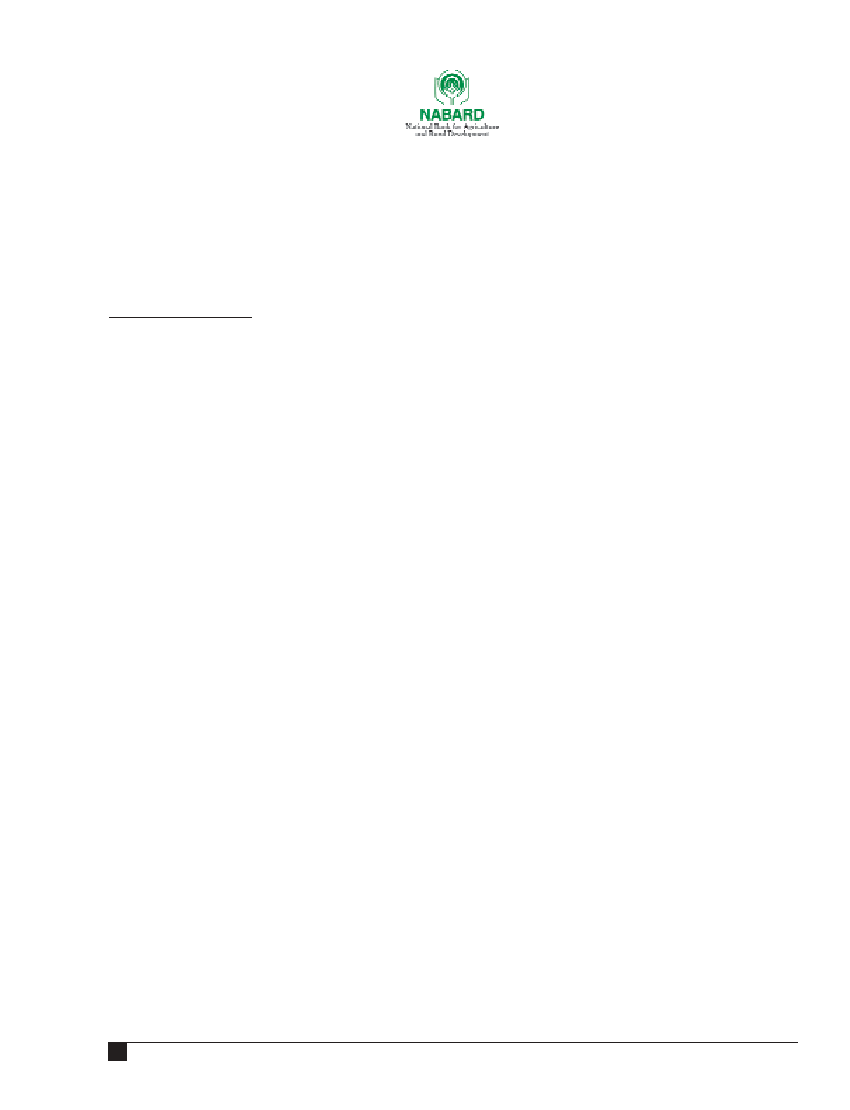
SUSHILA RAVINDRANATH
I
t is not very apparent yet, but one of India's fastest
growing businesses is microfinance. In India, the
organised microfinance industry is about ten years old.
The most popular model for these institutions is the
Bangladesh-based Grameen Bank. The micro entrepre-
neurs usually want to start ventures not amounting to
more than Rs 10,000. The interest they pay to the money
lenders make their borrowing completely unviable. For
example in the wholesale vegetable market in Chennai,
one can see people disbursing Rs 100 to various vegetable
vendors in the morning. By the evening the vendors have
to pay back Rs 120. This means they pay 20% interest every
day. These are the vegetable, flower, fish vendors, tea stall
and food stall owners who require funds and have no
recourse other than the money lenders.
The microcredit institutions (MCI) lend them this
amount without any security. The MCIs prefer to lend to
women rather than men. Some women give their borrow-
ings to men in their family. But they make sure it is
returned. In micro credit women make better borrowers.
The interest rates are not low. Instead of 50% charged by
the money lender it may be 38%. Still there is a saving. And
the default rate is negligible.
A survey conducted by RBI finds that most borrowers
say that it is easy or very easy to get a loan from microfi-
nance institutions (MFIs). They have a close monitoring
system which ensures that there are minimum defaults.
MFIs have a good recovery rate. District administration
received very few complaints against
MFIs. Almost all the bank branch man-
agers said that MFIs were good customers
of banks and they could be used as busi-
ness facilitators or correspondents.
However, microcredit is an operationally
difficult concept. According to people in
the business, if the loan amount is
Rs 5,000, the amount is collected over 50
weeks at Rs 120 per week. Usually five
women join together to take loans. It
becomes a collective liability. The field
development officer holds a meeting with all of them before
lending. Then the women pledge to pay back the amount
and the institution starts lending. The officer goes literally
everyday to follow up on the progress of a number of bor-
rowers for whom he is responsible. Each branch of the
institution has many such collection centres. Lending
radius is usually within one or two square kilometer. And
one has to get to know the people. Banks can never handle
something like this.
In spite of these hurdles there have been quite a few suc-
cess stories like SKS India which was launched in 1998. It is
one of the fastest growing microfinance organisations in the
world, having provided over Rs 6,212 crore and having
maintained loans outstanding Rs 2,216 crore to 3,906,007
women members in poor regions of the country. Borrowers
take loans for a range of income-generating activities,
including livestock, agriculture, trade (such as vegetable
vending), production (from basket weaving to pottery) and
new age businesses (beauty parlour to photography).
Spandana founded in 1998 is also one of the fastest
expanding microfinance institutions in the country. It is
also one of the most efficient in the country with an oper-
ating expense ratio of 5.5% on portfolio. It now boasts of a
client base that constitutes almost 1.5% of the BPL (below
poverty line) population of India. Then there is West
Bengal-based Bandhan, Chennai based Micro Credit
Foundation of India , all doing splendid work with women.
Once they are established MCIs can be channels for
other products like mutual funds, insurance and so on. It
is also possible to tie up these institutions with education
and healthcare. Now that several success
stories are emerging in this area, and the
spreads appear good, many larger com-
panies want to join the bandwagon. This
worries existing players. The big groups
they fear will push costs and salaries up
which will defeat the purpose of microfi-
nance. The industry also fears political
interference, government interfering with
interest rates and so on. Notwithstanding
some problems many firmly believe that
the future lies in microfinance.
SMALL IS PROFITABLE
Microfinance institutions have a close monitoring system which ensures that there
are minimum defaults with a good recovery rate
MICROFINANCE WORLD | April 2009
14
[
FEA
TURE
]
In microcredit
women make better
borrowers. The
interest rates are
not low. Instead of
50% charged by
the money lender it
may be 38%
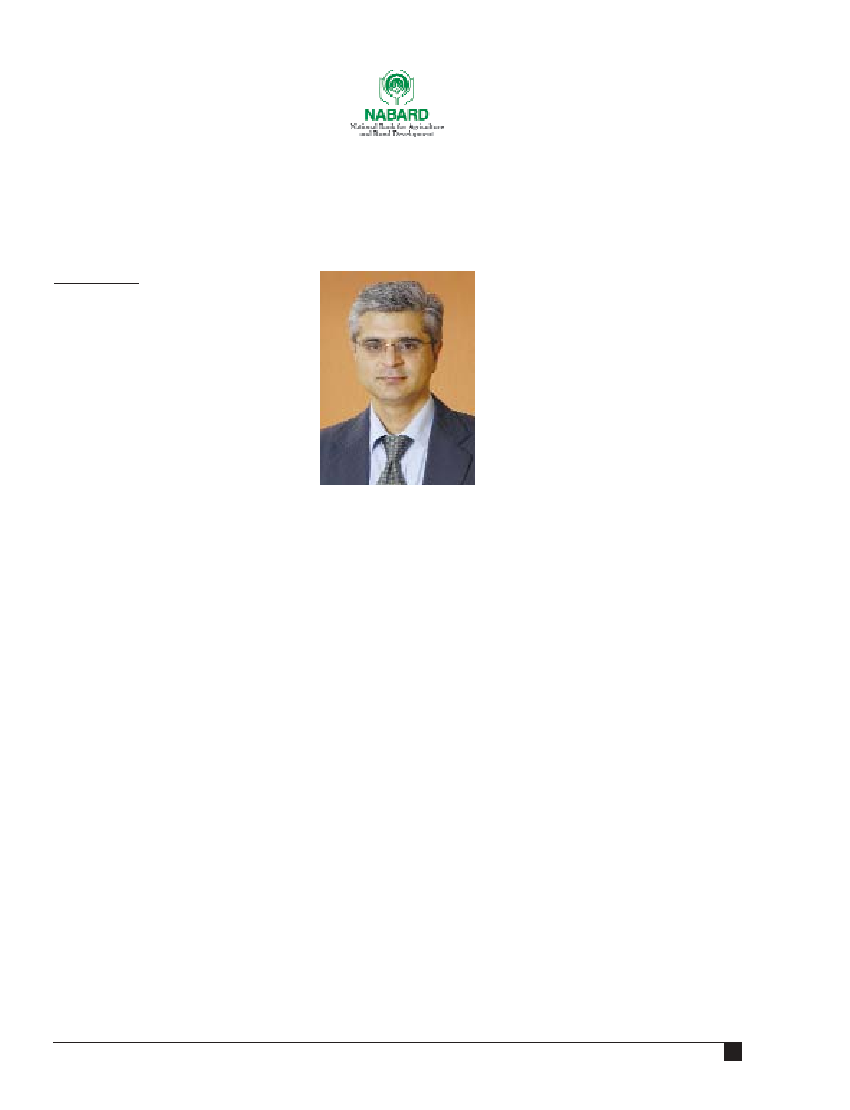
TARUN CHUGH
I
t is widely recognised that microfinance
is a powerful tool in eradicating extreme
poverty. As outlined in the millennium
development goals under the United
Nations Development Programme, the
basic approach adopted by the signatories
is built on the premise that over the time,
with the support from the state govern-
ments, village economies can transition
from subsistence farming to diverse com-
mercial activity.
The role of microfinance institutions
The first step towards achieving this is the availability of
credit for asset creation. Over the last decade, the microfi-
nance institution (MFI) movement originating from the
Grameen model in Bangladesh has proliferated worldwide
and made a significant difference to the rural economy. In
India too, commercial insurers traditionally have focused
on bundling basic life risk products with the MFI loans to
increase reach and convenience for consumers. However,
credit linked insurance is usually driven by very low premi-
um. For instance, ICICI Prudential Life's Sarv Jan Suraksha
has a minimum premium of Rs 50 per annum and provides
up to Rs 30,000 in case of an eventuality. This sum is usual-
ly adequate to cover the loan outstanding and, hence, pro-
tect the earning asset for the family. The premium is gener-
ally paid by the MFI as an extended credit to the member
and recovered along with the loan installments.
Creating value for consumers beyond credit insurance
Availability of credit, however, is a necessary, but not suffi-
cient, condition for sustainable financial inclusion. Given
that the low-income group families in the developing
world are specifically vulnerable to multiple idiosyncratic
and catastrophic risks, income protection in these markets
is as important as income generation.
Microinsurance not just plays a key role in meeting the
credit requirements of this segment but at the same time
provides them protection against the above stated risks,
creating tremendous value for consumers in safeguarding
their interests.
Regulatory environment
Regulation in India has been fairly proac-
tive on the need for microinsurance. The
Insurance Regulatory Development
Authority (IRDA) was the world's first regu-
lator to come up with specific microinsur-
ance guidelines in 2005.
Reaching out to the consumers
Microinsurance is no longer considered just
a subsidised business for meeting the IRDA
obligations. According to a UNDP report
published in 2007, microinsurance repre-
sents an untapped market of nearly $2 billion in India.
Consumer education
Consumer education on the need and importance of life
insurance at the community level in these markets is very
critical and needs to be carried out in isolation of advertis-
ing and promotion.
Product innovation
ICICI Prudential Life, for example, has designed a cus-
tomised product offering--Anmol Nivesh-- which is a sav-
ings and protection product designed exclusively keeping in
mind the need and income cycle of tea plantation workers.
Managing costs
Reaching out to this potential market needs to be cost
effective for it to be a viable business model for insurers on
a sustained basis. This makes it critical for various stake-
holders to pool in their resources towards achieving a
common objective. Pooling of data between insurance
companies and government bodies can help improve
actuarial calculations and in better pricing.
Public Private Partnerships
The Centre, as well as a few state governments, have taken
steps towards providing life and health risk cover to the
poor. One of the more popular ones--Rashtriya Swasthya
Bima Yojana--is now launched across the country.
The writer is Chief - Alternate Channels & Group, ICICI
Prudential Life Insurance Co. Ltd.
April 2009 | MICROFINANCE WORLD
15
[
COL
UMN
]
MICROINSURANCE: A SNAPSHOT
The life and health risk cover for the poor can contribute towards alleviating poverty
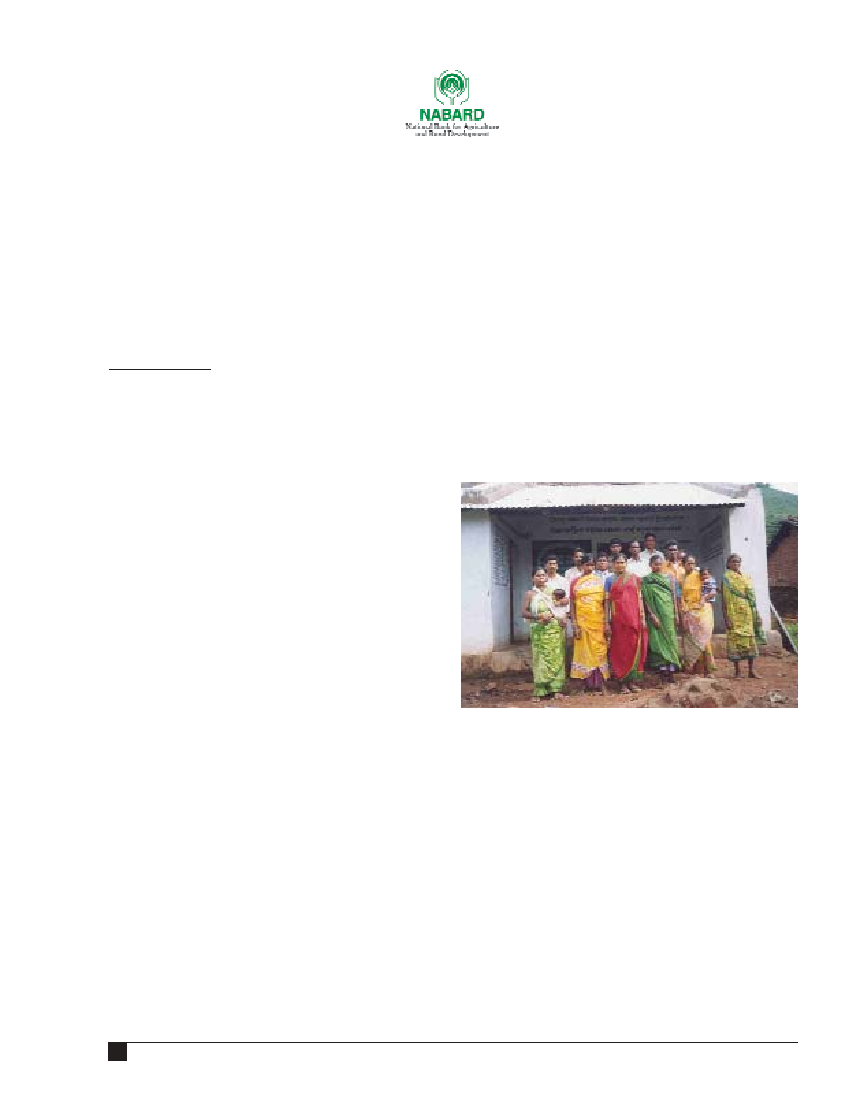
INDUMATI SAHOO
Grain Bank
Grain Bank is a kind of "Cereal Pooling Mechanism" at the
village level. The villagers contribute a portion of their own
harvested stocks of paddy, ragi and maize during December
and January to establish a village based fund in the form of
grains collectively to meet exigencies. The members of the
Grain Bank usually borrow during lean period during May
to September and repay the same along with interest in the
form of grains after next harvesting.
The concept of Grain Banks is quite popular among
many tribal and backward regions of the country. The
Grain Banks offer dual benefit to the members in the form
of food security as also the seed security depending on the
participating clients. They also offer a savings avenue to
the poor in the form of savings in kind.
With a view to synergise the concept of Grain Banks with
that of the Small help Groups (SHGs), two projects were
supported by NABARD, one each in Orissa and
Chhattisgarh with the following objectives:
a) To explore the possibilities of monetising the savings-
in-kind in the form of grains to explore the possibilities
of building synergy between SHGs in a village.
b) To understand the issues in participatory management
of Grain Banks in some of the dis-advantaged areas.
Orissa (Kalahandi district)
The Grain Bank project was piloted in the Rampur block of
the Kalahandi district with a mission of exploring the pos-
sibility of synergising the traditional practice of maintain-
ing grain banks with the SHG. The pilot envisaged mon-
etising savings in the form of grains by SHGs enabling
participatory management of grain banks by members
and securing the availability of food grains and seeds espe-
cially in the post monsoon period.
A total number of 17 villages of Thuamul Rampur block
of Kalahandi district were covered under the project. Out
of the 353 households in the 17 villages and hamlets, 263
belong to ST category, 42 to SC and 4 are of OBC category.
The land in this area is hilly land without irrigation facil-
ity. The livestock are mostly in the form of goats and cows.
The income level of most of the household is quite low.
It was observed that the food stress period is for about
nine months. The agricultural produce meets the food
requirement for only 2-3 months. A major portion of the
produce is used for liquidating the loan from the money-
lender. The lean season of food availability is from May to
September of the year and the food scarcity becomes
acute during rainy season. People get into the clutches of
the moneylenders during this period. The nearest bank
branch is at Gunupur about 25 km away.
Three Grain Banks were constructed in Silet, Sikerguda
and Maltipadar. All the three are in active operation in 17
tribal villages of Kerpai and Nakarundi GPs of Thuamul
Rampur block of Kalahandi district.
Three Grain Bank Committees were constituted with
members from different SHGs.
29 SHGs were promoted by the NGO, Antodaya.
SHGs started savings in cash and grain. Savings
mobilsed by the SHGs from members was Rs 1,59,025
and grain of 5,330 kgs (approximately).
The district administration took keen interest in imple-
menting and monitoring the project. SHGs have
GRAIN BANKS AND
SELF HELP GROUPS
In Orissa and Chhattisgarh repayment and distribution in any mode of grain led to
converting the produce of the area into money thereby facilitating savings
MICROFINANCE WORLD | April 2009
16
[
COL
UMN
]
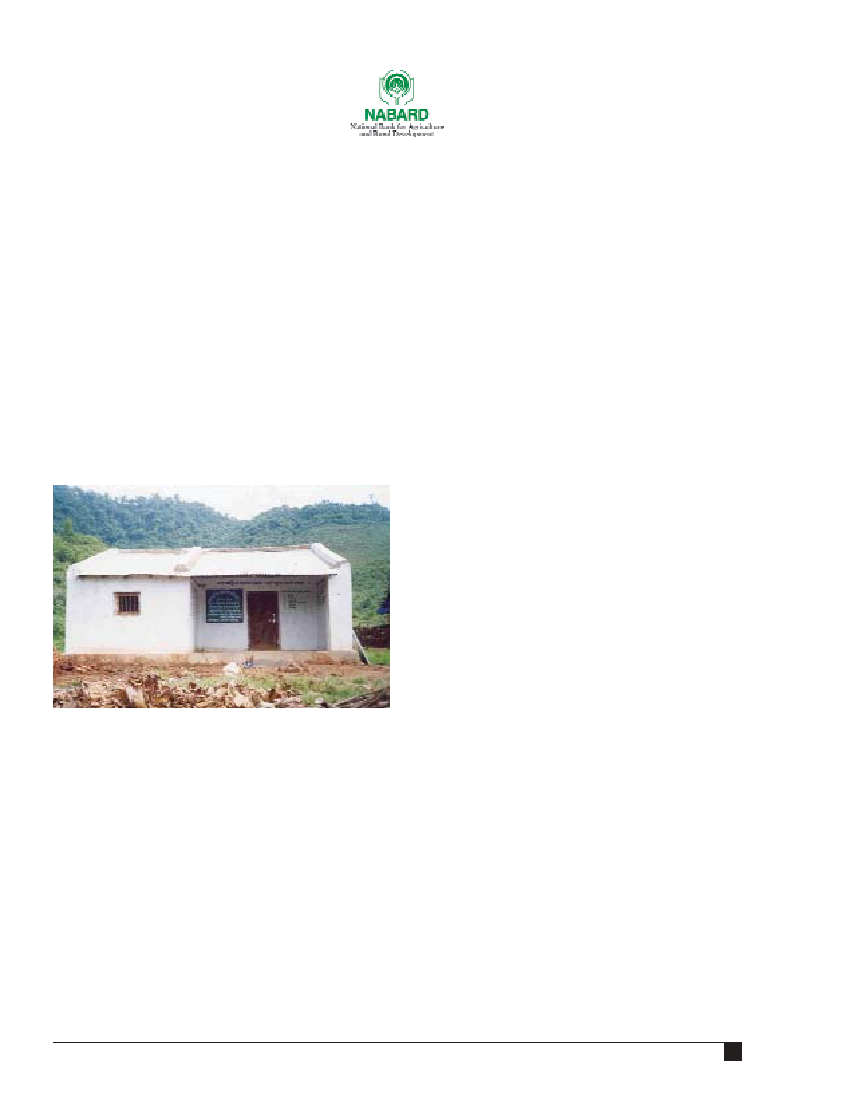
received support from external sources such as
Integrated Tribal Development Agency (ITDA) and
Orissa Tribal Empowerment and Livelihood Project
(OTELP) to an extent of Rs 1.45 lakh and Rs 1.5 lakh.
Cash in hand were to the extent of Rs 11,865, cash in
Bank were Rs 3,44,124 and the amount involved in inter-
nal lending were of Rs 1,36,642 by the end of May 2008.
Grains totaling 963 Kgs (rice, paddy, ragi and small mil-
let) have been saved by the groups. Kalahandi Anchalika
Gramin Bank provided loan aggregating Rs 3.75 lakh to
the groups.
Other benefits
The implementation of the pilot project for Grain Bank
among others highlighted the area so much that the
Government of Orissa selected it under Orissa Tribal
Empowerment and Livelihood Project (OTELP). The
micro watersheds are being developed and livelihood
programme are being implemented under the project.
Roads are being constructed to improve the connectiv-
ity. The flow of funds and the wages in the form of grain
and cash have facilitated better standard of living for the
people. The scarcity of grain has been reduced to a great
extent. But the people are keen to continue with the
Grain Bank as the OTELP project will be there for two
more years.
At the pre-development stage, about 97% of the families
were under food stress during 5-6 months and were
under the clutches of money lenders. In the post inter-
vention period no family was going to the mahajan or
the money lender for food grain during scarcity period.
For cash loan the bank linkage is proving adequate.
However, occasionally few families still go to money
lenders as the nearest branch is situated 40 km away
which gets cut off during monsoon.
People have gained confidence and can hold on to
their produce for a month or so by availing loan from
the SHGs. Last year they could sell kandul dal (wild
arhar) at higher price and sold tamarind for Rs 6 per kg
as against Rs 2-3 per kg hitherto. The training pro-
gramme under the project as well as frequent visits by
NGO personnel, Bankers and NABARD officials have
enhanced awareness level among the people of this
inaccessible area. They have succeeded in presenting
their problems before the district authorities and get-
ting their work done.
There was a campaign against alcoholism in Sikerguda
to Maltipadar villages by the women SHG members in
December 2007.
All women members are covered under Swasthyashree
Health Insurance Scheme run by women federation
Banashree Mahila Sangathan supported by Antodaya.
Chhattisgarh (Kanker and Bastar district)
To promote Grain Banks among the SHGs in the mono crop
areas of the state, a project on pilot basis for establishment
of five grain banks each in two villages of Bastar division was
sanctioned by NABARD with matching grant contribution
from Catholic Relief Society, an NGO. As per the project in
Markatola village of Kanker district, each grain bank was to
cover 3 SHGs involving 50 members for mobilising 50 kgs of
grain by each member. In the Mylibeda village of Bastar dis-
trict, each grain bank was to cover three SHGs involving 15
members each in mobilising 30 kgs of grain per year by each
member. NABARD had sanctioned Rs 2.375 lakh as grant
assistance towards 50% cost for establishment of 5 grain
banks each in the proposed two villages belonging to tribal
communities over a period of 2 years from the date of sanc-
tion i.e. 17 February 2005.
Markatola village
The village has about 400 households having population
of 2,200 scattered in 9 hamlets. About 50% of the house-
holds are tribals and depend on agriculture and wage
labour. Villagers largely reside in kuttcha mud houses.
The land holdings of the families vary between 1.5 to 4
acres. Only one major crop i.e. Paddy is grown in a year.
About 35% of the families avail crop loan from LAMPS
which is around 10 km away. The nearest bank branch to
the village is 2 km away.
Achievement
The NGO had introduced the Grain Bank among the vil-
lagers long back. Only problem faced was that of limited
storage space restricting the operations of the Grain Bank.
Five Grain Banks were completed, of which four were
April 2009 | MICROFINANCE WORLD
17
[
COL
UMN
]

constructed in community and panchayat land and the
remaining one in the land donated in writing in Gram
Panchayat forum by the land owner. The Grain Banks are
managed by a committee and secured with lock and key
under joint custody. The Grain Banks started functioning
with effect from March 2007. An extension worker of the
NGO staying in the area oversees the functioning of the
Grain Bank.
SHGs are base for all the Grain Banks. Members of 3 to 4
SHGs are the members of each Grain Bank. All the SHGs
associated with the Grain Banks were gathering grains at
uniform rate of 5 kata (15 kgs) per member after harvesting.
Mylibeda village
The village has about 200 households having population
of 1,500 scattered in 7 hamlets. About 95% of the house-
holds are tribals and depend upon agriculture and wage
labour. The average size of land holding of the households
is 4 to 5 acres. Only one crop i.e. paddy is grown in a year
as the village depends entirely on rainfall for cultivation.
The village is having one Anganwadi Centre and one pri-
mary school. Catholic Relief Society, the NGO has imple-
mented a watershed programme in the village. A residen-
tial school upto 10th Standard and a hospital are run by
the NGO in the village.
Achievement
14 SHGs were formed in the village and it was observed
that members were aware of the SHG concept and had
opened SB A/c with the RRB branch. The groups had
mobilised Rs 5 to 10 per month regularly. The Grain Banks
started functioning with effect from 1 December 2006. All
the grains contributed during 2006-07 was lent out.
The establishment of Grain Banks in the village
addressed the problem of resorting to the money lenders
by the villagers to a large extent. Because of Grain Bank, vil-
lagers remained united. They also organised recreational
activities in the village. Grain bank activity helped the vil-
lagers to organise and construct a check dam in the nearby
nala. They are now able to produce second crop on some
additional plots. Grain Banks have helped villagers in
developing close association with the NGO and getting
easy access to high school education and health facilities.
Learnings
Monetising the savings in kind
: The objective of monetis-
ing the savings in kind was achieved to a great extent in
Orissa. Bank loan routed through the NGO took into
account the savings in the form of grain while working out
the corpus of the group. The branch of the erstwhile
Kalahandi Gramya Bank (presently Utkal Gramya Bank)
could bring 364 household under its purview in one of the
most inaccessible areas of the Kalahandi district. The
SHGs of remaining part of the area i.e. Kerpai GP were also
credit linked through the effort of another NGO,
Shahabhagi Vikash Abhiyan and DRDA/ORMAS. Thus the
entire area could be brought into banking network. The
flexibility i.e. the repayment and distribution in any mode
of grain (either in the form of rice, paddy, pulses) led to
converting the produce of the area into money, facilitated
savings in grain, credit in the form of grain as well as cash.
Building synergy between SHGs and Grain bank
: The
synergy between Grain Banks and SHGs has brought in a
decentralised system for distribution and recovery with
the involvement of the community. This has led to the sus-
tainability of the Grain Bank.
Food Security And Participatory Management
: Food
security during the food stress period was the biggest chal-
lenge which has been addressed successfully as the people
could meet their requirement through Grain Bank.
Other developments:
The implementation of OTELP and
construction/repairing work of road are the major develop-
ment initiative by the Orissa Government. The develop-
ment work led to flow of grain and cash in the form of wages
and grant assistance for various livelihood programme.
Future Strtaegy
Grain Bank to be converted into commodity outlet :
The
tribals of the projects wanted to continue with the Grain
Bank scheme. The community is in the habit of saving and
the grain saved at the SHG level could be used for access-
ing funds from bank. The stock of grain with SHGs in vil-
lages may ensure food security particularly in the context
of food stress period during monsoon when the area gets
cut off. The Grain Bank can be converted into commodity
outlet and may be linked to the rural haat.
Grain Bank Committee to become Farmers club:
The
Grain Bank Committee may gradually become inactive
with less work in hand and may ultimately become
defunct. In order to enrich the job of the Grain bank com-
mittee and bring some integration for agriculture develop-
ment on a permanent basis Farmers club may be consti-
tuted in which the members of the grain bank committee
may become member.
Replication in other states
: This model of association of
Grain Bank with SHG bank linkage is relevant particular-
ly in remote inaccessible pockets of the country for bring-
ing such regions under the purview of the banks with sup-
port from NGOs.
The writer is AGM, NABARD
MICROFINANCE WORLD | April 2009
18
[
COL
UMN
]
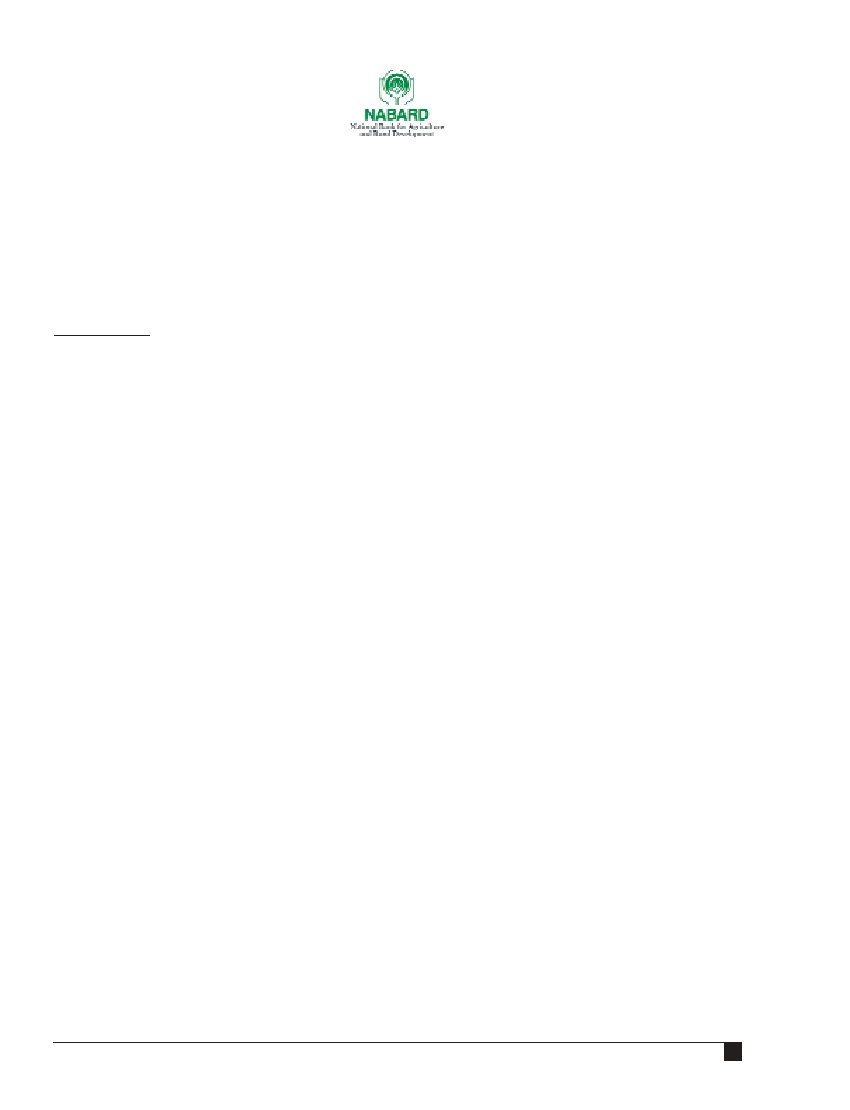
GOURI SHANKAR
S
tandard Chartered Bank's (SCB) engagement with
the development agenda is core to its focus on build-
ing a sustainable business. We believe that our long
term financial performance is dependent on having the
right social and environmental conditions for growth in
our markets. By engaging with our stakeholders we have
identified seven key areas where we can make the greatest
difference access to financial services is one of them.
Across Asia, Africa and the Middle East we provide a
customized product offering for all stakeholders in the
microfinance industry including: local currency lending
and banking products and services to our microfinance
institution (MFI) partners, risk participation structures
with development organisations, technical assistance (TA)
linkages with TA providers and global markets products for
international investors.
In September 2006 the bank announced its commit-
ment at the Clinton Global Initiative to establish a $500
million microfinance facility over a five-year period. In
view of the lean branch network of the bank, SCB follows
the wholesale model of bulk lending to MFI for further on
lending to the Self-Help Groups (SHGs)
and individuals. This facility will pro-
vide MFIs and fund managers with $500
million of credit, financial instruments
and technical assistance to finance
MFIs in Asia and Africa.
In India as on March 9, the bank had
an outstanding portfolio of $60 million,
with an outreach of about 0.75 million
clients spread across 15 MFI partners, a
majority of whom had a pan India pres-
ence. Our partners include a mix of
established intermediaries, urban start
ups and down-scalers. Products offered
include: term loans, overdraft limits and
cash management facilities. Over the
past year in particular, given the sizeable
growth in the operations of our partners
we have begun to support them in linking into the investor
community via the capital markets.
The bank views this as a channel for empowerment of
women and people at the bottom of the pyramid. With a
view to achieve scale, bank's microfinance business is sus-
tainable in nature with ample scope for expansion. With
millions of financially empowered client base created
through microfinance business, there are many other
business opportunities in the domain of micro savings,
micro pension and microinsurance etc. Except for micro
credit, the other financial products have not really reached
the clients and there lies new opportunities and chal-
lenges for banks and financial institutes.
Beyond building the business, the bank also invests in
the capacity of its partner MFIs through technical assis-
tance and trainings. Over the past year the bank has
invested in two training programmes for the microfinance
sector in India.
Though MFIs are improving their risk mitigation strate-
gies with growth, still there is scope for improvement and
the enhanced risk systems does not appear to commensu-
rate with the growth. With a view to contribute in this
important space, bank is trying to down scale its robust
risk management frame work to suit to
the MF industry and provide as a sec-
toral offering for the benefit of the
industry. The bank is working a
renowned industry training agency to
undertake this project.
The Indian microfinance sector mir-
rors the global microfinance sector in
terms of its development. The sector is
highly concentrated and a small number
of MFIs manage the majority of assets. In
a bid to develop new investment oppor-
tunities in the sector, we sponsored, for
the second time in two years, "SRIJAN", a
microfinance business plan competition
aimed at encouraging greenfield MFIs.
The writer is head Microfinance,
Standard Chartered Bank
April 2009 | MICROFINANCE WORLD
19
[
COL
UMN
]
LEADING THE WAY
Standard Chartered provides financial services credit, savings, banking products
and services to its Micro Finance Institution (MFI) partners across Asia, Africa and
the Middle East
Though Microfinance
Institutions are
improving their risk
mitigation strategies
with growth, still there
is scope for improve-
ment and the
enhanced risk systems
does not appear to
commensurate with
the growth

You have been with the main street banking industry
for almost 22-23 years. What brought you here to
microinsurance?
I was really excited by the opportunity in this market.
There are two things: One is sheer opportunity of the busi-
ness to transform life and really impact a poor person's life.
I come from South and my grand parents still live in a vil-
lage. So, I know what all adversities people go through
there. I was always very passionate about doing something
in this area.
In fact, when I was with the Barclays we tried making an
arrangement with SKS for mobile banking or tele-payment
facility. We were running a pilot then, but it didn't work
out then.
On the commercial front, we have a huge scale already.
We are the biggest microfinance company in India. If we
continue to grow at the same pace, we are hopeful of
becoming the largest microfinance company in the world
within next two years. Per month we are adding 2.5 million
customers and are targeting 15 million customers by the
end of financial year 2012.
What has been the most interesting experience for you in
SKS microfinance till now?
The way microfinance has changed the lives of poor peo-
ple is simply amazing. There are a lot of people I meet
who have taken loans from us and changed their lives.
However, there is one case that I remember quite vividly.
During one of my visits to the centres in Andhra Pradesh,
I had met a widow. She was then in the second cycle
of loan from SKS.
Before joining the SKS family, she used to work as a
labourer near her place and earned on per hour basis.
After her husband's death, she took a loan from SKS
Microfinance to buy a sewing machine and started sewing
clothes. Within one year, she managed to increase her
business two-fold and bought another sewing machine.
Apart from elevating herself, she employed other labour
class as well and helped increase employment opportuni-
ties in her area.
We also met her daughter and she spoke to me in
English. I was surprised! Then later the woman told me
that she supported her family and ensured good education
for her daughter. After completing her graduation, she was
then working in a call centre.
A loan from SKS elevated that widow from labour to
entrepreneurial class. There are many more cases where
women in dire conditions have taken loans from us and are
now proud owners of their small entrepreneurial set up.
People always question microfinance and doubt if it is
doing well or not. I'm totally convinced. We are not only
doing well but also making sure several people that are in
need too are doing well.
Besides disbursing loans, you also teach the borrower
how to write her name. Why?
We generally conduct three-day session before the loan
disbursement. In these sessions, women are told how the
whole microfinance set up works. We also teach them how
the interest is calculated, what the total amount that they
`WE HAVE BEEN GROWING AT 200%.
BY 2009 END WE SHOULD HAVE OVER
60-65 LAKH CUSTOMERS'
Suresh Gurumani took over as the CEO of SKS Microfinance last year after Vikram
Akula, the founder of SKS, stepped down to become a full-time director on the board
of the company. A banking veteran with 22 years of experience has set a clear
growth path for his company even during these times of slowdown. In an exclusive
chat with Suneeti Ahuja, Mr Gurumani shares his experiences working in the field of
microfinance. He outlines his plans of making SKS one of the largest microfinance
company and hopeful of targeting 15 million customers by 2012.
MICROFINANCE WORLD | April 2009
20
[
INTERVIEW
]
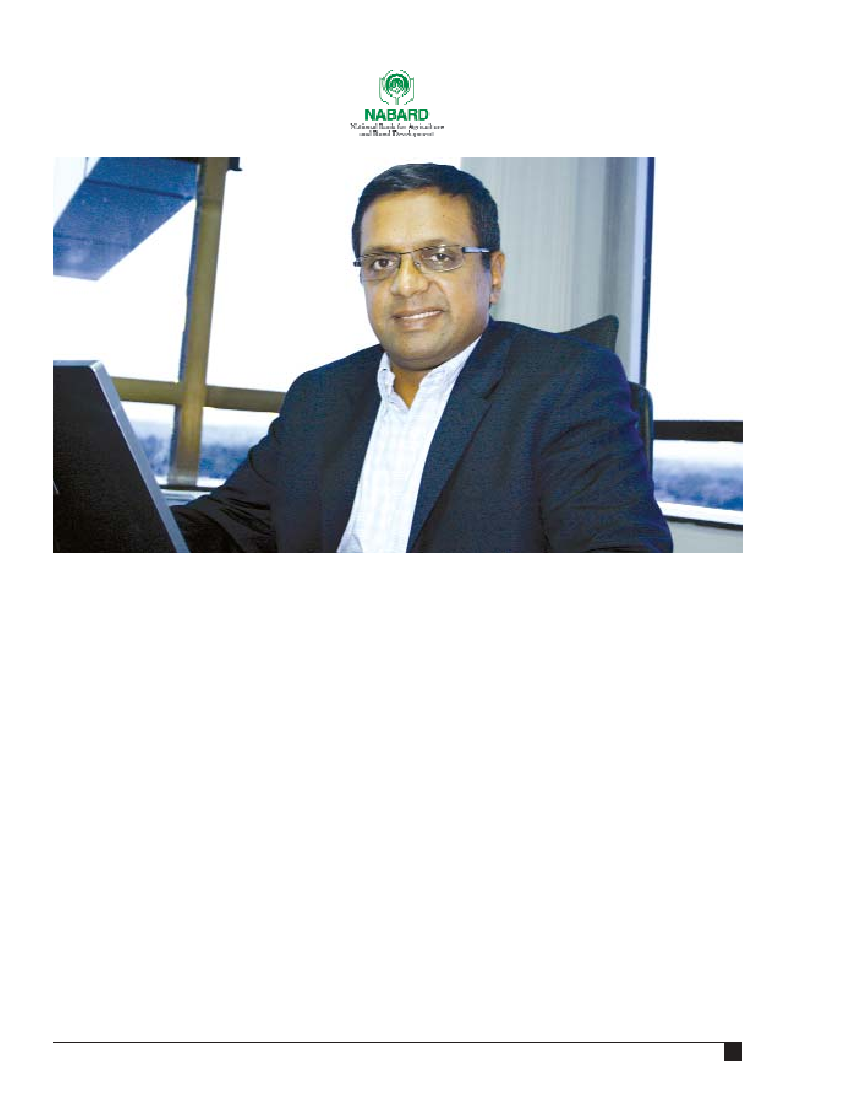
will be paying is and most importantly, how to write their
name. It instills a lot of confidence in the person.
Besides, whenever a woman takes loan from us, we
make sure that the respective husbands and families know
about the step. And finally, at the time of loan disbursal,
both husband and wife have to sign the document.
In fact, I remember an incident. On one of the loan dis-
bursal days, there was a couple that had come. After taking
the loan, they had to sign on the papers. Now the husband
wasn't literate and put his thumb impression on the paper
and the wife on the other hand, since she had gone
through that training program, took a pen and signed. We
could see the sense of pride in that act -- she felt superior
to her husband.
These are small things but have a very deep social
impact. One factor is the group part. Since we lend only to
groups of women, it binds some sort of binding to the soci-
ety as a whole. And that is lacking in the street banking.
How do you categorise poor people for disbursement
of loans?
We have divided them into three classes: upper poor, very
poor and ultra poor. While we disburse loans to the first
two segments, we give grants to the ultra poor. Say,
Rs 20,000 to buy a cow and then we teach them how to
feed and milk the cow and earn some money. We want to
make them commercially viable. So that is again a pilot
that is running. These are basically people who have
income of less than $1 per day.
We are also working with Forbes on a project to ensure
some sort of entrepreneurial opportunity for this segment.
You do not ask for any collateral at the time of loans.
What is the default rate and who are your customers?
Most of the people that take loans are migrants. This is a
business that is purely driven on trust. The group model
makes it really successful. We make groups of five and dis-
burse the loans to them. One important point is that the
members of the group should not be blood relatives. Then
it is the responsibility of the group to ensure that all the
members pay their due instalments in time. In case some-
body defaults then the group has to pay for that person.
So far we have had recovery rates of almost 100% even
in state of Bihar, where people might think we would have
problems. Our recovery rate is 99% per cent.
Disbursal of loans is done after all the due diligence
from our side.
You are a profit making organisation. What is the
turnover for the company last year?
Financial figures are confidential. In terms of growth, we
have been growing at 200%. In India, right now we have
close to 40 lakh customers, which should be over 60-65
lakh by the end of this year.
April 2009 | MICROFINANCE WORLD
21
[
INTERVIEW
]

Are there any bottlenecks that you face in this industry?
There are two types of challenges that we face: internal
and external challenges. Let me first talk about the internal
challenges. The first one is rural connectivity. We set up
branches and then need to make sure that the information
is reaching those branches in time. But now with the
broadband connections being available almost every-
where, this problem is being resolved pretty fast.
The other challenge is people. We have a branch head
and then other people that facilitate the whole process.
And we make it a point to employe the localities. Most of
the people working or heading these areas are 10th pass.
We ask for references from the local people and based on
the references, we fill the vacancies. We strongly believe
that there should be an empathy with the customers.
On the external challenges front, we have bureaucratic
hurdles. As a company, we have set principles that we are
unwilling to give in. So it takes a lot of time at times to open
a new branch. Then lending from banks is also a concern.
Although, the condition is better off now, Vikram Akula, the
founder and now the chairman of SKS Microfinance faced a
lot of problems. Most of the banks were not ready to lend
then, as they could not figure out how we could lend with-
out collaterals and give unsecured loans. And now, we are
the biggest borrowers from the banks.
Then there are problems like Naxalism.
What is the rate at which you borrow from the banks?
And what is the rate of disbursal?
Currently, we are borrowing at 13.5%. We give the loans at
the rate of interest of 24% to 28%.
Why such a difference in interest rates?
There are two costs involved in this business: one is the
operating cost and second cost is interest cost. Since, we
have to go far flung areas to do everything, it incurs a lot of
operating costs. And then we have to take care of the inter-
est part as well.
To take care of all the costs, we charge the borrower as
per the higher slabs. But as we scale up and bring our costs
down, we tend to reduce the rate of interest charged as
well. Like in Andhra Pradesh and Karnataka, we charge
12.5% as the member base is high, where as in areas where
we are yet to reach the critical mass we charge 15%. And in
turn, pass on the benefit to the customers.
Are there any other initiatives that you are working on
for this segment?
There are quite a few initiatives that are underway. In
terms of rural reach, we have about 1,400 branches. What
we are looking at is a holistic rural economy. While micro-
finance is one way, through the reach, we are planning to
introduce good-quality products to the rural masses.
For instance, we have a pilot running with Unilever for
supplying water purifying systems. Through these sys-
tems, the poor get access to clean drinking water. We have
a special arrangement with the company that poor people
to pay for these systems in installments. Thus, we are try-
ing to provide access to better life to the poor through our
wide reach.
We already have a pilot project running in Andhra
Pradesh and Orissa. Soon we should be able to launch the
services everywhere. We are also running another project
on solar light.
We look at products that are good for the customers. And
we bundle the finance option for the customers. For exam-
ple the water purifier is for Rs 1,800 and the solar light is
between Rs 1,250 to 1,800. We are also planning to roll out
another set of services mobile. We have tied up with Airtel
and Nokia for this. Besides the business part, these can also
be used by the families.
You have grown to quite a significant level. Going for-
ward would you also look at other types of loans and also
expand the reach to men as well?
First, we give loans only for entrepreneurial work and have
no plans to increase this to other types of loans.
And why only women? That is because I think women
are more risk-averse. As they are the ones who handle the
household expenses, they are more responsible with the
loans. We feel there is still huge opportunity in this area.
And therefore, would not want to widen our reach in terms
of men borrowers right now.
Are you planning to expand overseas as well? And if yes,
where do you see the opportunity?
We cannot say anything right now. But yes, there are
opportunities in China and Far East.
MICROFINANCE WORLD | April 2009
22
[
INTERVIEW
]
There are quite a few initiatives that are underway. In terms of rural reach, we have
about 1,400 branches. What we are looking at is a holistic rural economy. There are
quite a few initiatives that are underway. In terms of rural reach, we have about
1,400 branches. What we are looking at is a holistic rural economy
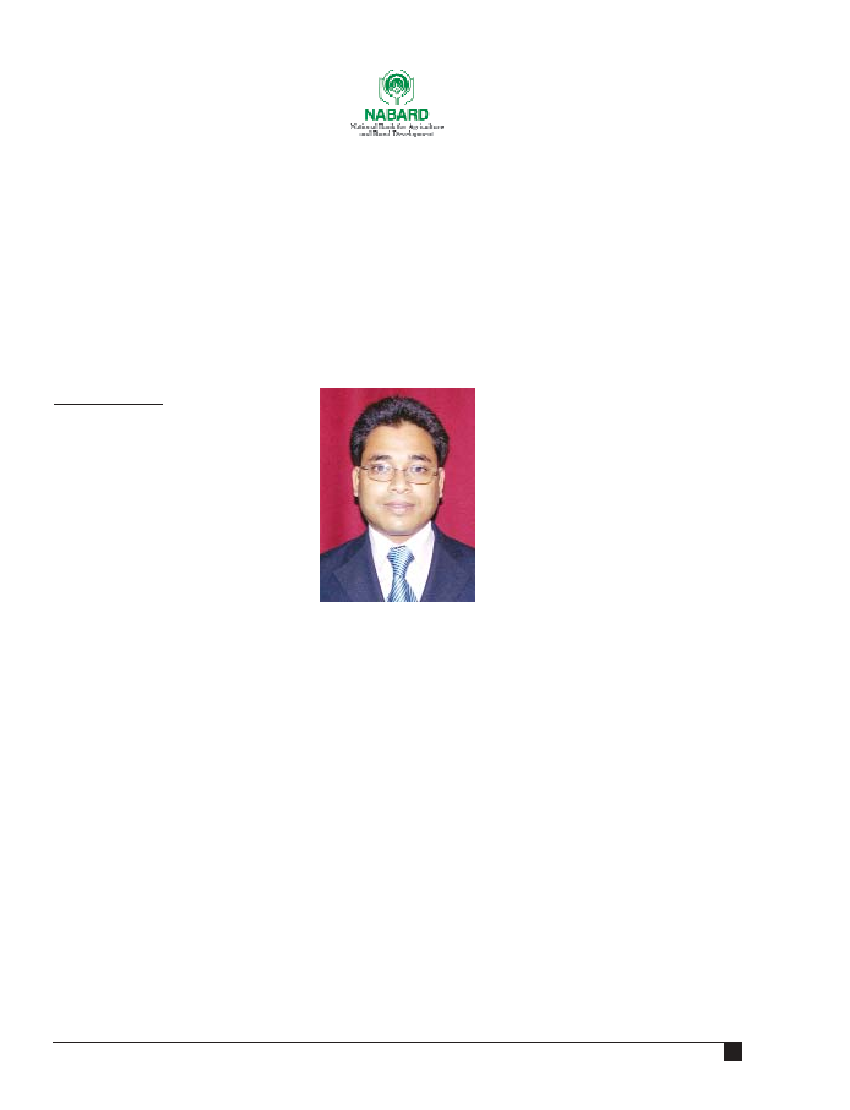
AJAYA MOHAPATRA
S
ince the beginning of the global eco-
nomic downturn in mid-2007, the
world is debating what would be the
impact of financial crisis on the microfi-
nance (MF) sector. MF has emerged as one
of the pivotal strategies across the globe for
alleviating poverty by enabling poor to
raise their income and socio-economic sta-
tus. The history suggests that since last two
decades microfinance institutions (MFIs)
are largely resilient to the financial crises.
As compared to other mainstream financial institutions,
MFIs are immune during the financial crises including the
currency crises in East Asia and banking crises in Latin
America in the 1990s.
It is due to the fact that during that period the microfi-
nance sector was very small and the external borrowings
including equity and debt to the MFIs were very limited
due to their not-for-profit in nature. Yana Watson of
Dalberg Global Development Advisors (Microfinance
Insights, March/April 2009 issue) writes that "only a hand-
ful of MFIs had even begun to contemplate transforming
into regulated deposit-taking banks with access to com-
mercial funding sources. But by the early 2000s -- with
Banco Compartamos' bond issuance; Bank Rakyat
Indonesia's first microfinance IPO; and the emergence of
microfinance collateralised debt obligations (CDOs) --
microfinance had burst onto the international capital
market. With the United Nations naming 2005 as the Year
of Microcredit and Prof. Mohammad Yunus receiving the
Nobel Peace Prize for the work of Grameen Bank, microfi-
nance seemed to emerge as the darling of international
development. By 2007, an estimated $5 billion of foreign
investment had flowed from developed nations into MFIs
around the world."
How it affects MFIs in India
MFIs in India can be broadly divided into
two categories, for-profit and not-for-prof-
it MFIs. For-profit MFIs are generally the
non-banking finance companies (NBFCs)
regulated by RBI, whereas the not-for-
profit MFIs are registered under societies
or trusts, charitable companies u/s 25 of
Companies Act, mutually aided coopera-
tive societies (MACs) and cooperatives. As
per Sa-Dhan's Bharat Microfinance Report
2008 that provides information on 223
MFIs of India, suggests that almost 60% of
the market shares in terms of loan portfolio and 76% of
the client outreach are controlled by 10% of the largest
MFIs in India.
Unlike in Africa, Central Asia, Eastern Europe and
Bangladesh, in India, MFIs are not allowed to take deposits
or savings, which is a substantial source of funding for the
MFIs in these countries. As per Microfinance Information
Exchange, Inc. (MIX) 2006-07 benchmark data, MFIs
across the globe raised capital from various sources that
includes 36.2% from borrowings, 35.8% from deposits,
15.5% from equity, 9.9% from other debt includes conces-
sionary loans and compulsory savings, 2.5% from dona-
tions. Thus, a substantial capital raised by the MFIs was
derived from deposits.
On the need to provide all the microfinance services,
Vijaya Mahajan, Chairman, Basix Group, says that the
MFIs should provide services like micro credit, micro sav-
ings, insurance, micro mutual funds and remittances in
order to promote financial inclusion and improve quality
of life of poor.
MFIs in India are deprived of taking deposits; therefore,
they are largely dependent on external funding available at
the local/public sources or borrowing from international
sources. Due to their dependency on the external borrow-
April 2009 | MICROFINANCE WORLD
23
[
COL
UMN
]
THE IMPACT OF FINANCIAL
CRISIS ON MICROFINANCE
The history suggests that since last two decades microfinance institutions (MFIs) are
largely resilient to the financial crises. They are immune during the financial crises includ-
ing the currency crises in East Asia and banking crises in Latin America in the 1990s

ings, MFIs in India may be affected by
the financial crisis due to lack of ade-
quate capital to manage volatility,
depreciation of local currency, increased
costs on borrowings and tighter net
interest margins.
In order to enable the MFIs to address
the financial crisis, SIDBI CMD says that
it had released double the amount of
loan in 2008-09 as compared to the last
fiscal. Besides, SIDBI has also started
providing long-term loans to the MFIs.
Government Initiatives
In order to address the financial crisis,
the government of India has taken
proactive measures by providing various
stimulus packages to maintain growth
in the SME sector including microfi-
nance. In November 2008, the RBI
extended a $1.5 billion credit line to
SIDBI primarily for emergency liquidity
for SME, under which SIDBI has the dis-
cretion to use the new liquidity to
finance MFIs. In India, initiatives to
increase liquidity and lower foreign
exchange risk have done much to ease
the impact of the crisis on the microfi-
nance sector. The Central Bank lifted
foreign lending restrictions to non-bank
financial companies (many of which are
MFIs), let the rupee depreciate to slow
the outflow of capital, and is providing
extra funding to the financial sector
(Global Financial Crisis: Implications for
South Asia. October 21, 2008). However,
in spite of such measures initiated by
the Central bank to maintain growth in
the microfinance sector, the nation-
alised and commercial banks are still
hesitant to lend to the MFIs especially
the small and medium ones. If the indif-
ferent attitude of the nationalised and
commercial banks towards the MFIs
continues to persists, vision of the gov-
ernment for financial inclusion is going
to be a distant reality.
The author is the CEO of an MFI We The
People. He can be contacted at ajayamo-
hapatra@wethepeople.co.in
MICROFINANCE WORLD | April 2009
24
[
COL
UMN
]
People Group meetings at Nari branch, Una, Himachal Pradesh
P. Chidambaram visiting
We The People's stall
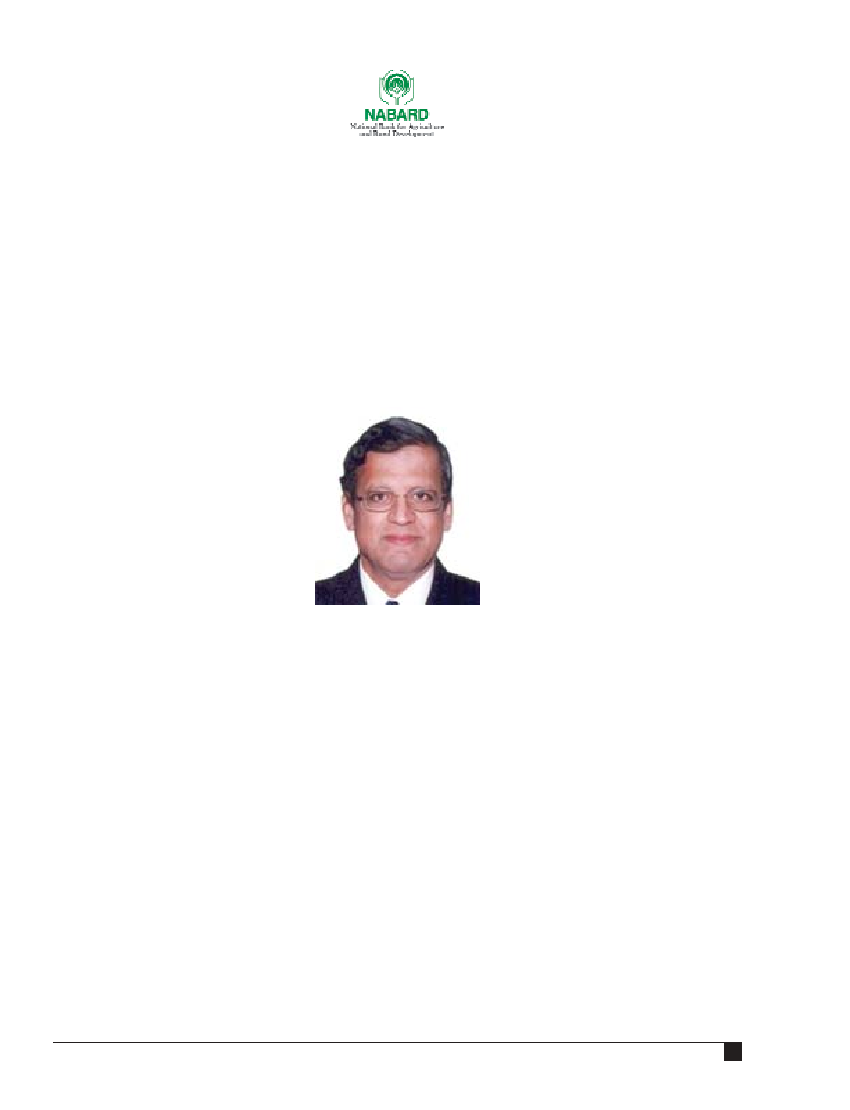
April 2009 | MICROFINANCE WORLD
25
[
INTERVIEW
]
How are you trying to develop the mki-
crofinance sector?
The existing branches of Indian Bank in
rural and semi urban areas were set up with
an aim to provide services to the SHGs
along with the normal banking services.
Special window has been in operation in
select rural and semi urban branches where
concentration of SHGs is observed, called
Micro credit Kendras, where focused atten-
tion is being given to the needs of SHGs by
staff for the purpose. However, in metro
and urban areas, the financial requirements of urban poor
is high, hence an exclusive branch for microfinance in oper-
ation called Microsate Branch. These branches act as `One
Stop Shop' for the needs of urban poor.
What kind of interest rates is charged for SHGs?
For short term loan, we charge up to Rs 2 lakh-11.50%
(BPLR* less 1.00%)
For short term loans above Rs 2.00 lakh - 12.50% (BPLR)
(*BPLR Bench Mark Prime Lending Rate of the Bank
which is at present - 12.5%.)
How much loans have you disbursed so far?
Cumulatively we have disbursed Rs 2,090.94 crore benefit-
ing 2.93 lakh SHGs up to March 9 which includes repeat
finance.
Is it profitable business for banks?
Yes, the yield on advances under SHG portfolio is quiet
good. The transaction cost of financing SHGs is low. The
Bank derives accrued benefits by cross selling individual
loan schemes to SHG members. Intangible benefits include
image building for the bank by touching the lives of the peo-
ple at the bottom of the pyramid. These poor are relieved
from the clutches of the local money
lenders, who charge exorbitant rate of
interest and the amount of interest paid to
the money lenders now form part of their
savings. Apart from financing the groups,
we have made arrangements for social
security of the members of SHG, by floating
a low premium life insurance policy for
SHG members in association with LIC.
What are the segments in microfinance
you are looking to finance?
We are concentrating in direct small help group bank link-
age programme to reach out to more SHGs directly. The
present outstanding is over Rs 1,300 crore in this segment.
We provides credit to SHGs in the form of cash credit,
term loan for their micro enterprise ventures. Also, custom
made special loan products have been formulated by the
Bank for the housing needs of the members (IB
Grihalakshmi), Education needs of the wards of SHG mem-
bers (IB Vidya Shoba), Consumption needs of members (IB
Grameen Mahila Sowbhagya) and direct loan for the con-
sumption needs of them.
What was your achievement on the front in 2008-09?
The bank has lent to 90,421 groups Rs 1,054.04 crore dur-
ing 2008-09. The balance outstanding was Rs 1,350.08
crore on March 2009 with 1.55 lakh SHGs. We have also
received `First Prize', second year in a row, for best perfor-
mance under SHG Bank Linkage among Commercial
Banks in Tamil Nadu during 2007-08, The award was given
by NABARD.
During the year 2008-09, we have opened dedicated
microfinance branches in 13 centres in Tamil Nadu,
Andhra Pradesh and Kerala. With this we are now having
25 microstate branches across the country in 10 states.
`WE ARE CONCENTRATING IN DIRECT
SHG BANK LINKAGE PROGRAMME TO
REACH OUT TO MORE SHGS DIRECTLY'
After having three decades of experience in banking MS Sundara Rajan, assumed
charge as Chairman & Managing Director of Indian Bank in 2007. In an interview
with Kumud Das of FE he shares his views on the topic.
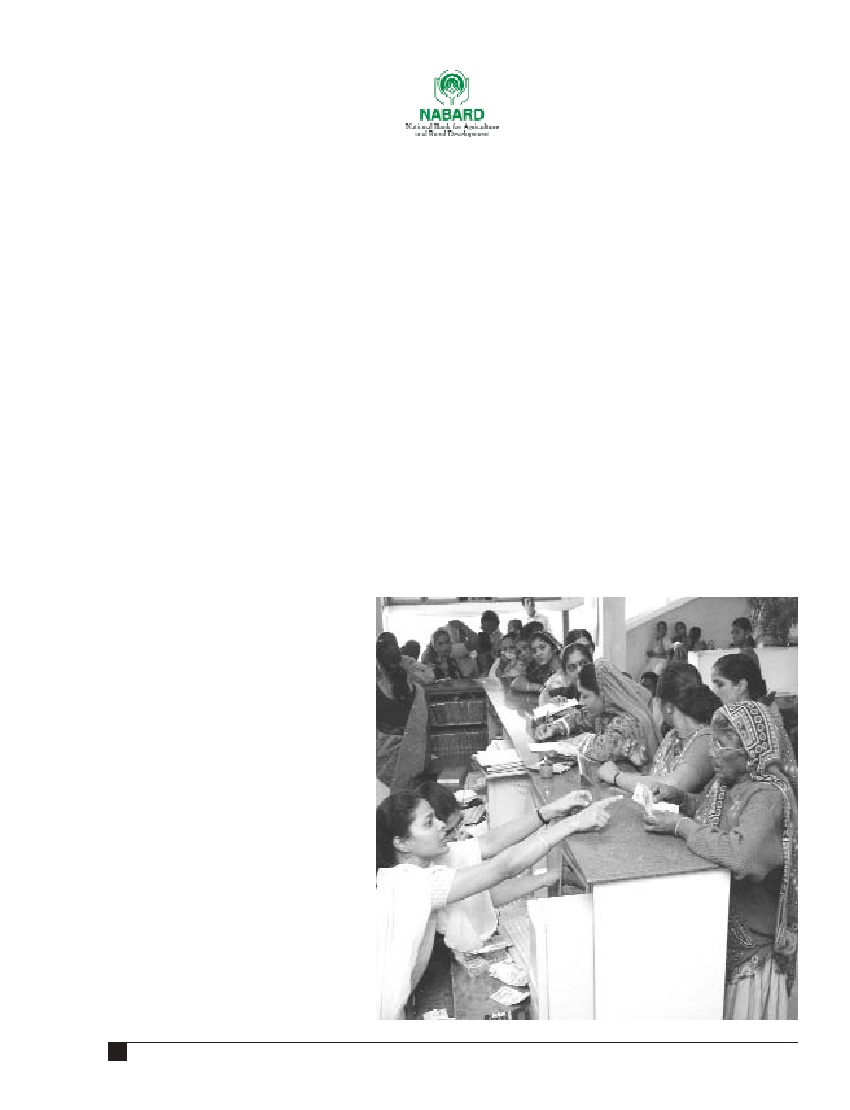
SEWA has grown large in its presence.
Please elaborate on this.
SEWA is the single largest trade union in the
country with a membership of 11 lakh
women, mostly vegetable and garment ven-
dors, in-home seamstresses, head-loaders,
bidi rollers, paper pickers, construction
workers, incense stick makers, and agricul-
tural workers. Based in Ahmedabad,
Gujarat, within two years of its launch in
1972, we started SEWA Bank, a cooperative
bank whose capital is made up entirely of
the members' own contributions. The bank
was founded by 4,000 women, each con-
tributing Rs 10 each. We have been in the
mainstream of union movement and in the
banking sector. Today we have more than
100 cooperatives. We have two companies,
marketing and two brands, the local and the
fancy embroidery.
What difference has SEWA made in the
lives of its members?
Thanks to SEWA, a large number of women
have been employed and their work is
`MFIs, IF LINKED WITH LIVELIHOOD,
HAVE A VERY CRUCIAL ROLE TO PLAY IN
THE GROWTH OF THE ECONOMY'
Widely regarded as a pioneer and a global entrepreneurial force in grassroots devel-
opment, Ela R Bhatt is also known as a `gentle revolutionary'. This is no mean feat,
considering her life-long dedication to improving the lives of India's poorest and
oppressed women workers. Ask her about her inspiration and Bhatt attributes it to her
Gandhian thinking. "It has guided me throughout my life," says she.
In 1972, Bhatt founded the Self-Employed Women's Association (SEWA), a trade
union which today boasts of more than 1,000,000 members. She is also the Founder-
Chair of a number of agencies, including the Cooperative Bank of SEWA, Sa-Dhan (the
All India Association of Micro Finance Institutions in India) and the Indian School of
Micro-finance for Women. Elaben shares her thoughts with Monalisa Sen
MICROFINANCE WORLD | April 2009
26
[
INTERVIEW
]
SEWA Bank Branch
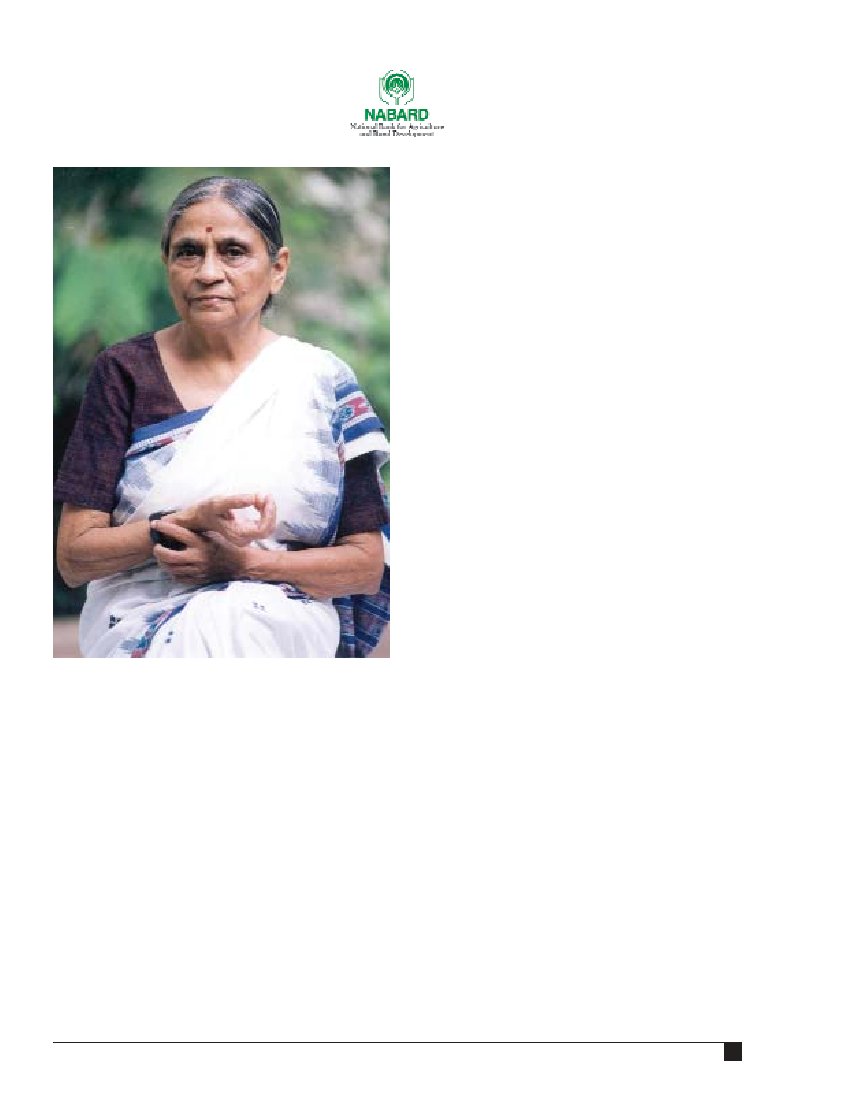
being recognised. SEWA has also been instrumental in
teaching them new skills, which, in turn, has helped them
improve their agriculture. This has immensely helped all
these women to step into the mainstream, with confi-
dence. Sewa has a little section which mainly deals with
changing of the laws and intervening into issues.
How can micro finance institutions help in the growth of
the economy?
Microfinance institutions, if linked with the livelihood,
have a very crucial role to play in the growth of the econo-
my. It is also important to link it to social security, namely
health and general insurance (life insurance). I believe
that it should be linked to social security. For example,
SEWA bank has a pension scheme. If the products are
according to the lifecycle of the poor and women, then it
helps in filling up the gaps.
There is also a need to empower them with education.
At SEWA, we teach financial literacy in a big way. Each of
our members are taught when to opt for a loan and when
to save. We impress upon them that they should take loans
only when it is for productive purposes, and not for other
needs such as marriages, etc. Such expenses can be taken
care of by savings. We tell our members that they should
create financial products in such a way that makes them
less vulnerable and that fills up the gaps from their income
going down.
You always adopted Gandhian method at SEWA? Please
comment.
I'm a product of the latter years of the freedom movement
in our country. During my school and college years, all my
teachers and everybody around us were always talking
about independence. My maternal grandfather, partici-
pated in the Salt March and was even jailed. Two of my
maternal uncles also were jailed during freedom struggle.
At SEWA, we have used Civil Disobedience when it
comes to combating a very large force like state govern-
ment. At times when you are baffled by the total ignorance
at the hands of the government, when they don't t respond
or become insensitive to our needs or even when they are
unjust to the marginalised, practicing Gandhiji's Civil
Disobedience is the only way forward. One should always
be self reliant to be able to do what he or she wants in life.
You have inspired hundreds of women to be self-reliant.
What is the guiding force that has helped you in this
endeavour?
Self reliance is not a pious virtue. What is important is inter-
dependence. In my case, I have been a product of those
days when our country was fighting for independence. I was
in college when India got freedom. In those days, rebuilding
the nation and finding alternate means was the most
important sentiment all over the country. Gandhiji had
shown the way and also set up the value system for all of us.
Has SEWA been affected by recession?
Recession has definitely impacted SEWA. First of all, the
industries that were directly connected with exports, such
as those involved in construction and diamond, have been
badly hit. But those in garment making they have not been
affected so much. For example, the construction labour
who was getting employment after earthquake hardly gets
as much work now. The migrant labours who used to go to
different cities for work is going back to his village.
Does the formation of a new government help you over-
come these problems?
I would say that both the ruling party and the opposition
should work together. That's the challenge for the new
government.
April 2009 | MICROFINANCE WORLD
27
[
INTERVIEW
]
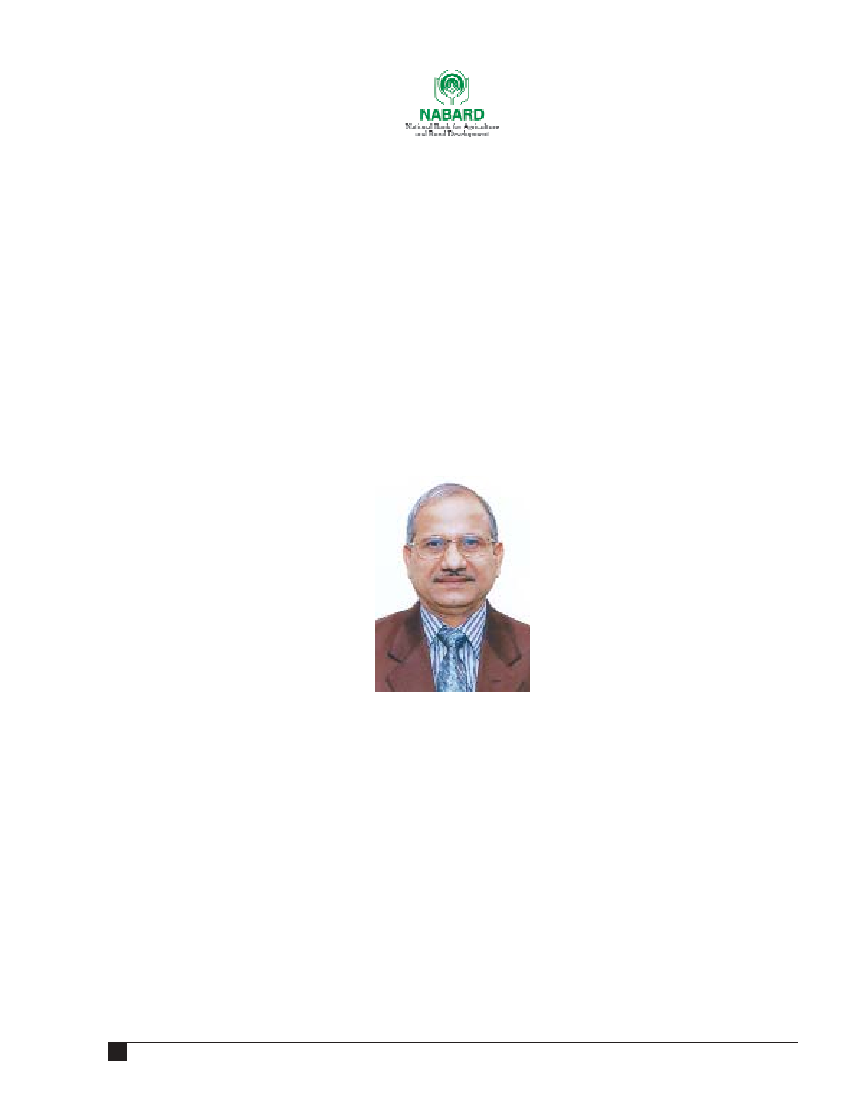
MICROFINANCE WORLD | April 2009
28
[
INTERVIEW
]
What strategies have you adopted to
develop the microfinance sector?
We have tried to develop the microfinance
sector by adopting the following strategies:
a) Provision of broad range of financial ser-
vices i.e. deposits, loans and payment sys-
tems to poor and low income households.
b) Identification of proper delivery
models like Self Help Groups (SHGs), Joint
Liability Groups and Microfinance
Institutions (MFIs).
How are you trying to develop the micro-
finance sector?
Based on the above strategies we are trying to develop with
the following initiatives:
No Frills Accounts:
We came out with `No Frills Account'
facility, `Star Saral Bachat Account' with simplified KYC
norms to be complied. It can have minimum balance of
Rs 50 in rural and semi-urban branches and Rs100 in
urban and metro branches. Our branches are also allowed
to open savings accounts with zero balance. So far we
have opened more than 16 lakh savings `No Frill Accounts'.
General Purpose Credit Card:
We have introduced
`Samanya Credit Card' for extending credit facility in the
nature of revolving credit. The Samanya Credit cardhold-
er is entitled to draw cash from the specified branch of
the bank up to the sanctioned limit. The bank has also
issued about 2,100 general purpose credit cards and con-
sidered overdraft against No Frill Accounts to the tune of
Rs 320 lakh.
Star Bhumiheen Kisan Credit Card:
We have also
launched Star Bhumiheen Kisan Credit
Card to bring the tenant farmers, share
croppers and oral lessee who were so far
outside the purview of the Bank to the
banking fold.
Rural Mobile ATM:
We have started a
Rural Mobile ATM in Sivaganga in Tamil
Nadu covering about 10 villages, thus
reaching the doorsteps of farmers.
Micro Credit Programme:
We have
financed MFIs for promoting and extend-
ing finance to the SHGs. The bank has
financed 21 MFIs for on lending to SHGs.
It has more than 1,42,000 SHGs linked with
the bank credit for various productive activities.
E-grama:
We have introduced a project E-grama, where-
in the farmers have access to commodity prices and get
information on new agricultural technology. The bank
has assisted in setting up rural kiosks in various states.
Business facilitators and business correspondents:
We
have introduced business facilitators model and accordin-
gly approved 63 business facilitators on the panel in six
states. Seven business correspondents with their 81 BC sub-
agents are approved and taken on panel in Maharashtra,
Madhya Pradesh, Andhra Pradesh and Uttar Pradesh.
Use of IT:
We are using IT enabled financial inclusion
solution for implementing 100% financial inclusion at
Raigad district of Maharashtra, Sehore district of Madhya
Pradesh, Lucknow, Barabanki and Hardoi districts of Uttar
Pradesh and Chittoor District of Andhra Pradesh.
Biometric Smart Cards have been used to provide door
step services through handheld devices terminals (voice
`OUR EFFORTS IN THE NEW FISCAL
YEAR WILL BE FOCUSED AROUND
CUSTOMERS AND COMPETENCIES'
Microfinance can be an effective tool for poverty reduction. Improved access and
efficient provision of savings, credit, insurance facilities can enable the poor to
smoothen their consumption, build up their assets, manage their risk better, devel-
op their micro enterprise and enhance income earning capacity. In an interview with
Kumud Das of FE, AP Ghugal, the general manager of Priority Sector Credit Dept,
Bank of India, shares his views:
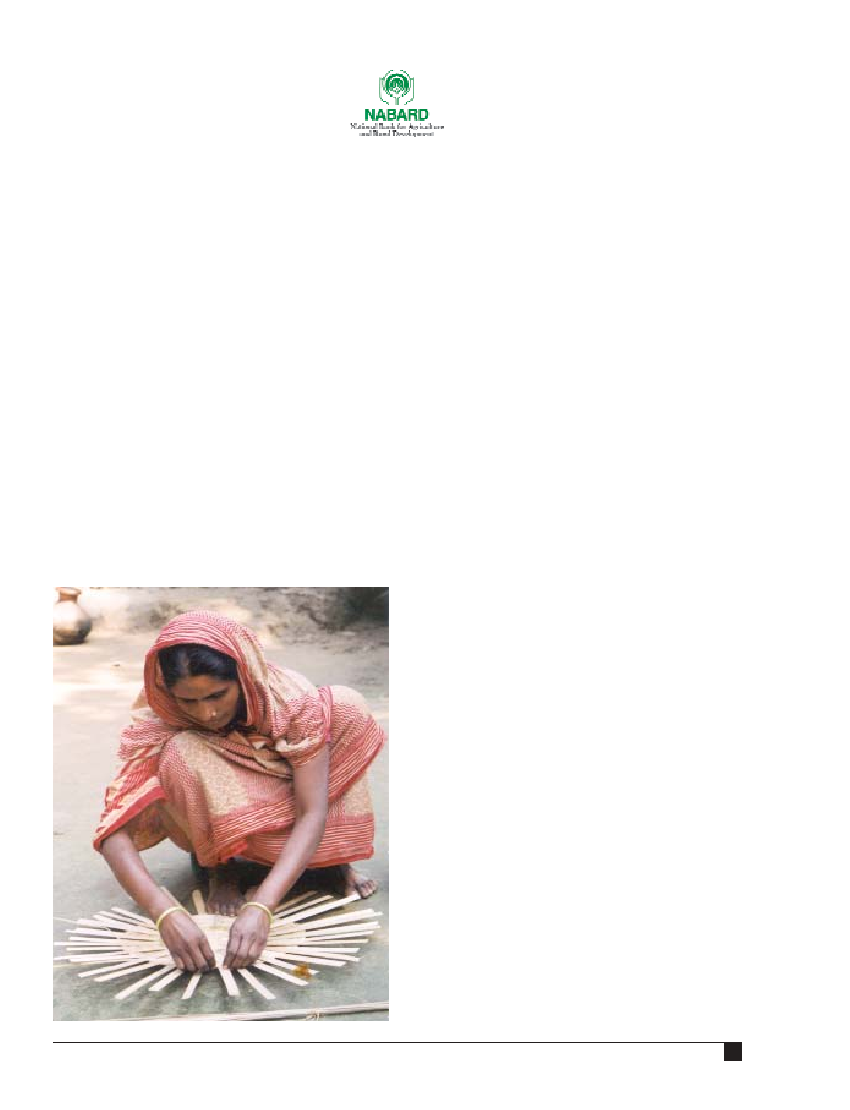
prompt enabled) to the financially excluded villagers at
their doorsteps with the help of approved business corre-
spondents and their sub-agents at free of cost. So far, we
have enrolled 87,000 accounts and have issued 52,000
Biometric Smart Cards. This facility has proved to be per-
fect `Branchless Banking Model' providing cost effective
financial services at the doorstep of rural people.
What kind of interest rate are you charging for them?
We are charging concessional rate of interest to SHGs i.e.
9% per annum irrespective of size of the limit. The rate of
interest to MFIs is stipulated on the basis of limit sanc-
tioned and credit rating of the institutions. At present, it
ranges between 9% to 12%.
How much loans have you disbursed to them so far?
We have more than 1,42,000 SHGs credit linked to the
bank with financial outlay of Rs 580 crore. The bank has
also extended finance to 21 MFIs aggregating Rs 240 crore.
Is it a profitable business for the banks?
Considering the cost of funds, cost of operations and
interest rate structure, we cannot say that it is a profitable
business proposition. At the same time it is not a loss mak-
ing business. Margins are very narrow. However, we have
taken up this challenge as corporate social responsibility.
What are the segments in micro finance you are looking
to finance?
Finance is extended to allied agriculture activities, retail
trade, small business, road transport operators, micro
enterprises, etc.
What was your achievement on the front in 2008-09?
During the year we have opened 13,800 savings accounts
of SHGs of which 11,330 savings accounts are women
SHGs. The number of SHGs linked with bank credit during
the year is 11,800 with financial outlay of Rs 122 crore.
Out of this, 10,400 women SHGs are linked with bank cred-
it with finance of Rs 104 crore.
Going forward, how do you see the new fiscal?
Our priorities and efforts in the new fiscal year will be
focused around customers and competencies. We will con-
tinue to develop our microfinance sector. The bank has
adopted poverty reduction as its overreaching objective
and bank shall respond to this challenge effectively. Our
aim is to have overall development of financial system.
What business do the MFIs do?
MFIs have become a key factor in transforming funda-
mental attitude towards development and alleviating
poverty. The core activity of the MFIs is to provide
financial assistance to SHGs for their productive activi-
ties. MFIs also extend finance to SHG for consumption
needs of the group members, housing requirements of
the poor people, creation of infrastructure in rural area,
sanitation, etc.
What are the geographical areas where you operate ?
Our area of operations is in the entire country. We have a
network of more than 3,000 branches of which 1,250
branches are located in rural areas. We are shouldering
lead bank responsibility in 48 districts where 1,009
branches are functioning and providing banking services
to the customers.
What are the problems faced by this sector?
In the remote, hilly and sparse infrastructure area, physi-
cal access itself acts as a deterrent. Illiteracy acts as a bar-
rier. High transaction cost and procedural hassles.
Requirement of independent documentary proof of iden-
tity is important barrier in having a bank account especia-
lly for migrants and slum dwellers.
April 2009 | MICROFINANCE WORLD
29
[
INTERVIEW
]
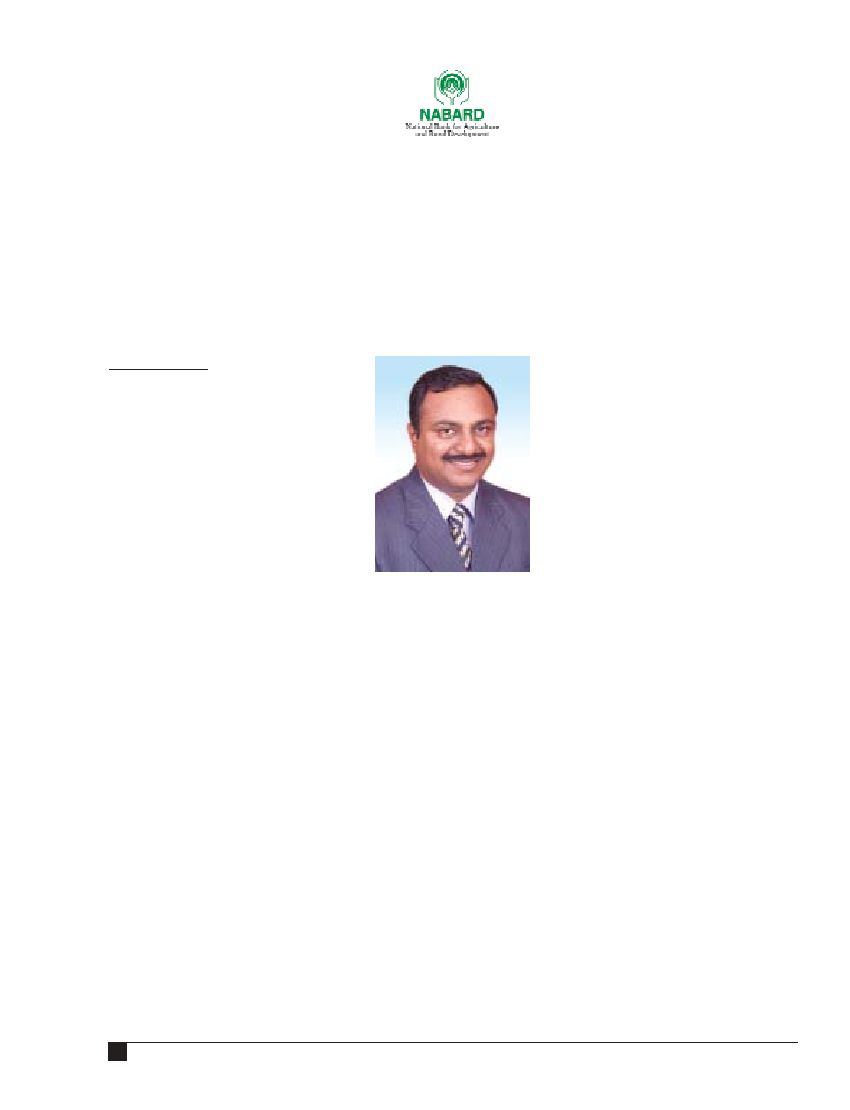
TARUN AGARWAL
T
he Indian Banking system has
grown enormously in the last five
years keeping pace with and in
some cases leading the country's remark-
able economic growth. With a large rural,
agro-dependant population, microfi-
nance has emerged as a viable means of
economic upliftment.
A large majority of the population in the
country still lives under $2 a day and in
extremely poor conditions. This section of
the society urgently needs to be brought into the economic
mainstream to achieve inclusive growth. The role of the
financial sector in achieving this inclusive growth compris-
es of providing financial services to this segment and this is
where sustainable micro finance models play a crucial role
to achieve substantial financial inclusion.
Financial Exclusion
: is construed as the inability to
access necessary financial services in an appropriate form.
A basic banking account should not be considered a
luxury, but a fundamental right of every citizen. This no-
frills saving bank account is only a necessity, but not a suf-
ficient condition for financial inclusion of the poor. Thus,
financial inclusion is delivery of not only banking, but also
other financial services like insurance, pension, remit-
tance, mutual funds, etc. delivered at affordable, though
market driven costs.
Gradations of Financial Exclusion
:
Core Exclusion: Who operate their financial affairs com-
pletely outside the regulated financial system
Limited Access: May have a basic bank account but poor
financial habits and little advice
Included but using inappropriate products: Victims of
inappropriate products.
Extent of Need for Financial Inclusion
It has been found that on an all India basis 59% of adult
population in the country have bank
accounts in other words 41% of the popu-
lation is unbanked. In rural areas the cover-
age is 39% against 60% in urban areas. The
unbanked population is higher in the
North Eastern and Eastern regions.
Benefits of Financial Inclusion
Safe platform for financial activities
transactions are more transparent and fair
Provides formal identity and a mecha-
nism for mobilisation of savings
It helps in enhancing entrepreneurship
From the banks perspective, financial inclusion pro-
vides
Untapped market expanding customer base
Acquisition of low cost deposits
Help diversifying exposure as well as customer base
Social growth and also a profitable proposition
Publicity and visibility to the Bank
Compliance to RBI & GOI
Challenges to Financial Inclusion
Some of the main challenges include coverage, cost of
small value transactions, infrastructure, suitable products,
flexibility, weak delivery model for community enterprise
and financial management support.
Models for Achieving Financial Inclusion
Bank & Government led financial inclusion
Bank & Corporate led financial inclusion
MFI's led financial inclusion
Bank & Technology led financial inclusion
Corporate led Financial Inclusion
Corporate led financial inclusion is relatively new in India.
Under the said model currently few corporate names have
been heard, like; ITC e-choupal, Cadbury's, Reliance, NDDB
MODELS FOR ACHIEVING
FINANCIAL INCLUSION IN INDIA
Banks would need to adopt an innovative, customer-friendly approach to increase
their effective reach so that share of organized finance increases
MICROFINANCE WORLD | April 2009
30
[
COL
UMN
]
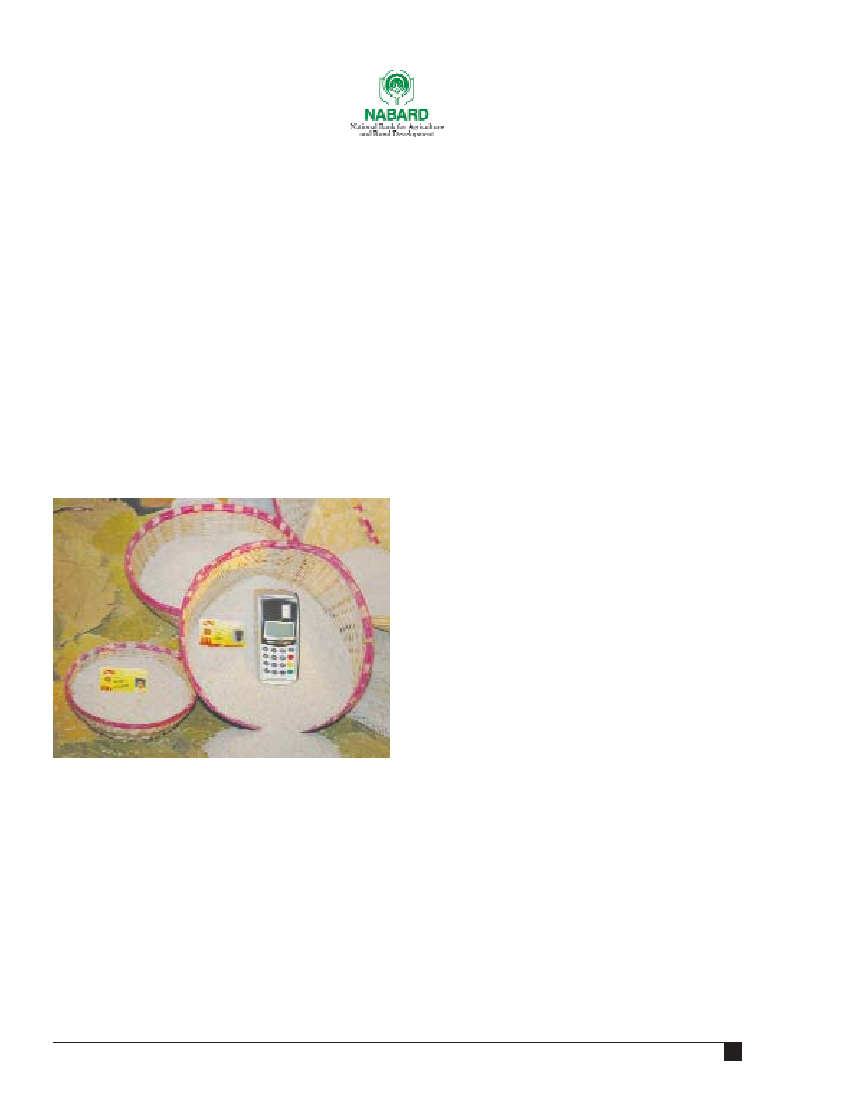
etc. Till date, most of the corporate's have been looking at FI
in India as one of their corporate social responsibility (CSR),
but now they take it as one of their strategy to retain and
build stronger relationships with farmers.
MFI led Financial Inclusion
Some of the popular Microfinance credit lending models
adopted is as follows:
Associations
: In this context, a target community forges
together to form an association through which a variety of
microfinance activities are initiated. The microfinance
activities may also include savings. The associations may
comprise of youth, women
Bank Guarantees
: A bank guarantee is utilised when a
loan from a commercial bank is needed.
Community banking
: This financing model considers
the whole community as one unit and facilitates the estab-
lishment of semi-formal and formal institutes through
which microfinance are administered.
Co-operatives
: Sometimes the cooperatives also
include savings activities and member-financing as well.
Credit Unions
: A credit union is a member-driven
unique self-help financial institute comprising of mem-
bers of a specific group like labor unions or a social frater-
nity who assent to save money and make loans to each
other out of that fund at reasonable interest rates.
Grameen
: The grameen model entails that a bank unit
be composed with a field manager and a set of bank staff
covering a specified area, like 15 to 20 villages. Finally,
groups comprising of five future borrowers are formed,
out of which only two people get the loan, and if within
fifty weeks they return the principal plus interest, as per
the banking rules, the others become eligible as well. This
is done, so that there is a collective liability on the group,
which serves as guarantee against the loan.
Intermediaries
: As the name suggests this model is a
`go-between' organisation operating between the lender
and borrower. They play a critical role of creating credit
cognizance like starting savings programs and thus raising
the credibility of the borrowers to a sufficient level. These
intermediaries can be NGOs, individuals, etc.
Non-Governmental Organisations: NGOs are very active
in the field of micro-credit, be it creating consciousness of
the importance of micro-credit, or developing tools and
resources to monitor and identify righteous practices.
Rotating Savings and Credit Associations
: In this
model a group of people join together and make periodic
cyclical contributions to a common fund that is given to a
member in a lump sum. After receiving the amount the
member starts paying back by making regular contribu-
tions. Bidding or lottery makes the decision about whom
the money should go to.
Small Business Enterprises (SME)
: They get loans from
micro-credit programs for creating employment, increas-
ing income etc. The micro credit is either provided direct-
ly to the SME or as a part of a bigger SME development
programme.
Village Banking
: This is community based banking
wherein 25-50 low income individuals who seek self-
employment come together to collect funds and give loans.
Different Technological Models:
Composite handheld
devices; simputers; PDAs
;
programmed mobiles and Tijori
micro deposit machines.
We have a structured a set of financial products from
FINO that its customers can offer to end customers. The
products are simple to use and have brand names like
Tijori (a safe, or locker) and Tatkal (prompt, or instant)
that the end customers can easily understand and relate
to. The delivery channels allow user transaction to be com-
pleted online as well as offline, using a simple point of
transaction (POT) device and a smart card that every cus-
tomer is issued. The smart cards are used for storing
demographic and financial information about the user,
and also contain the user's fingerprint image which is used
for authentication.
Banks would need to adopt an innovative, customer-
friendly approach to increase their effective reach so that
share of organised finance increases. Formal financial
institutions such as, banks, insurance companies, mutual
funds, pension companies will have to join hands with
small NGO-MFIs, larger NBFC-MFIs, and technology
providers to enable inclusion.
The writer is head-Financial Inclusion Consulting Group,
FINO
April 2009 | MICROFINANCE WORLD
31
[
COL
UMN
]
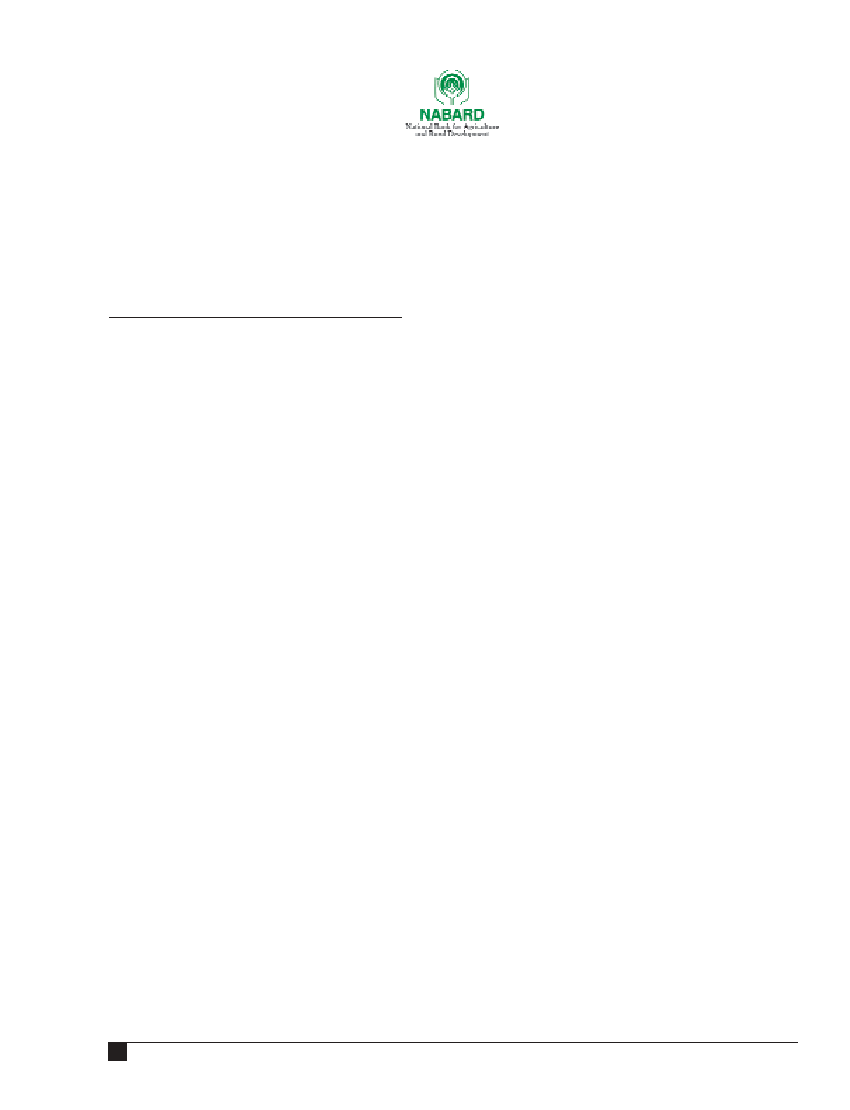
NACHIKET MOR, PRERANA LANGA and NAJIM DOST
W
hile India's recent economic performance
makes it one of the world's fastest growing
countries, many of its citizens continue to live
in extreme poverty, with 42% living on less than Rs 56 per
day (World Bank 2005). To find ways to address the root
causes of this poverty and empower the poor to participate
in and benefit from the Indian growth process, the ICICI
Foundation for Inclusive Growth (IFIG) was founded by
the ICICI Group in early 2008.
We believe that our fundamental challenge is to create a
`just' society one where everyone has equal opportunity
to develop and grow.
Focus Areas and Strategic Partners
Human capacity: basic health and elementary education
We believe that good health and basic education are
fundamental pre-requisites to achieving inclusive growth.
Basic health: ICICI Centre for Child Health and
Nutrition (ICCHN) www.icchn.org.in. Through ICCHN,
we work to strengthen the ability of the government to
deliver basic healthcare and nutrition to every child
from the time of conception until the age of three.
Elementary education for all: ICICI Centre for
Elementary Education (ICEE) www.icee.org.in. Through
ICEE, we work to strengthen the ability of the govern-
ment to provide high quality education to every child
from pre-school through elementary school.
Markets: Access to complete markets
Access to comprehensive financial services is therefore an
essential part of the development process. Financial ser-
vices enable individuals and enterprises to allocate their
resources most productively by allowing them to better
manage risk (e.g. buy insurance) and take advantage of
future opportunities.
Access to finance: IFMR Trust Advocacy Unit www.ifm-
rtrust.co.in/ventures/ifmr_foundation.php. Through
IFMR Trust Advocacy Unit, we work to ensure that every
individual and every enterprise has complete access to
financial services.
Sustainability: Promoting environmental sustainability
and the growth of a strong civil society
Ensuring that every individual has the freedom and the
power to create and sustain a just society and thereby ben-
efit from the Indian growth process requires additional
efforts on the part of civil society and policymakers.
Grassroots organisations and regulatory infrastructure, for
example, must be strengthened to ensure that the market
does not exploit marginalised sectors of the population or
the environment.
Environment: Environmentally Sustainable Finance
(ESF) www.ifmr.ac.in/cdf/esf.htm Through ESF, we
support policy and regulations that ensure that growth
and development processes proceed in an environmen-
tally sustainable manner.
Strong civil society: CSO Partners www.csopartners.org.in
Through CSO Partners, we seek to support social change
and build a defence against exploitation of all kinds by
strengthening civil society organisations (CSOs).
The Foundation provides active support and mentorship
to each of these strategic partners. Our five strategic partners
in turn work closely with additional partners at the commu-
nity level, building networks and deepening the effects of
our programmes. In the coming year, we will refine our
approach using what we learn on the ground in order to
ensure that our work will have an enduring and positive
effect on the lives of low-income Indian households.
In addition to our work in the area of inclusive growth,
the Foundation is working with ICICI Group of Companies
to support their various corporate social responsibility ini-
tiatives, which are designed jointly with them. With ICICI
Prudential Life Insurance, for example, we are developing
plans for support services for elderly citizens, civic safety
forces and healthcare for low-income households in rural
areas. With ICICI Ventures, we are rolling out initiatives for
micro enterprise development in rural and semi-urban
locations. With ICICI Bank, we have provided support for
their "Read-to-Lead" programme.
Nachiket Mor, President and Prerana Langa, VP-Strategy
and Communications, ICICI Foundation for Inclusive
Growth; Najim Dost, Senior Analyst, Strategy Advisory
Group and Joy Miller, Development consultant
TOWARDS INCLUSIVE GROWTH
The fundamental challenge of the Foundation is to create a `just' society one
where everyone has equal opportunity to develop and grow
MICROFINANCE WORLD | April 2009
32
[
COL
UMN
]
